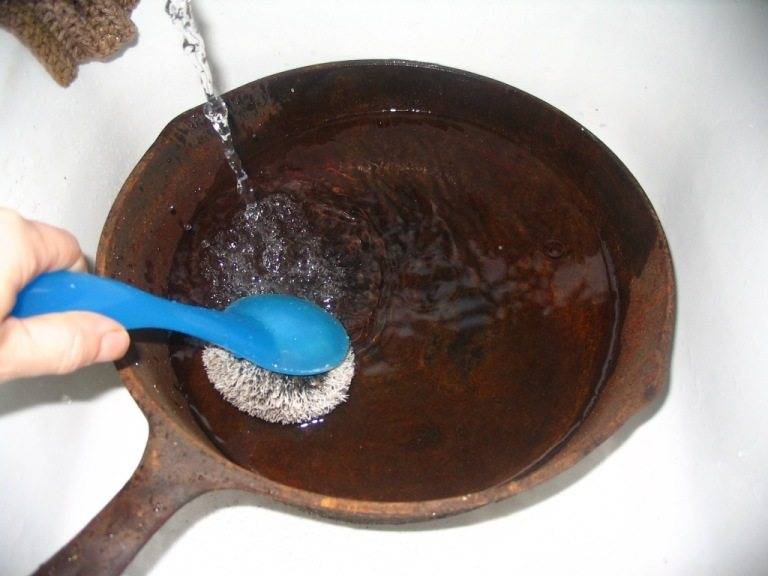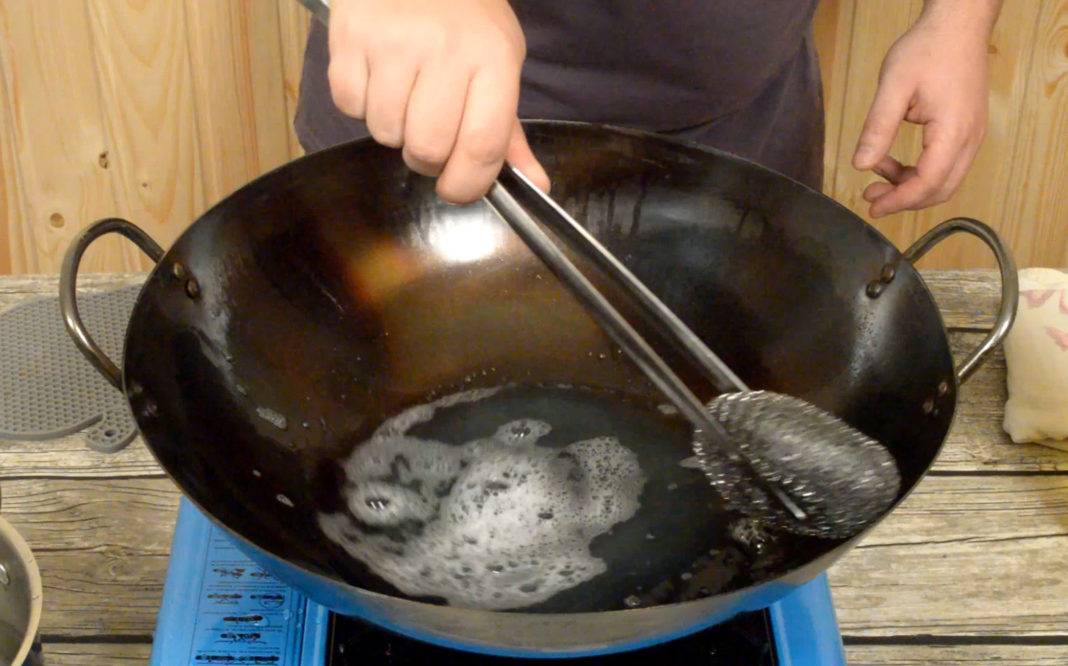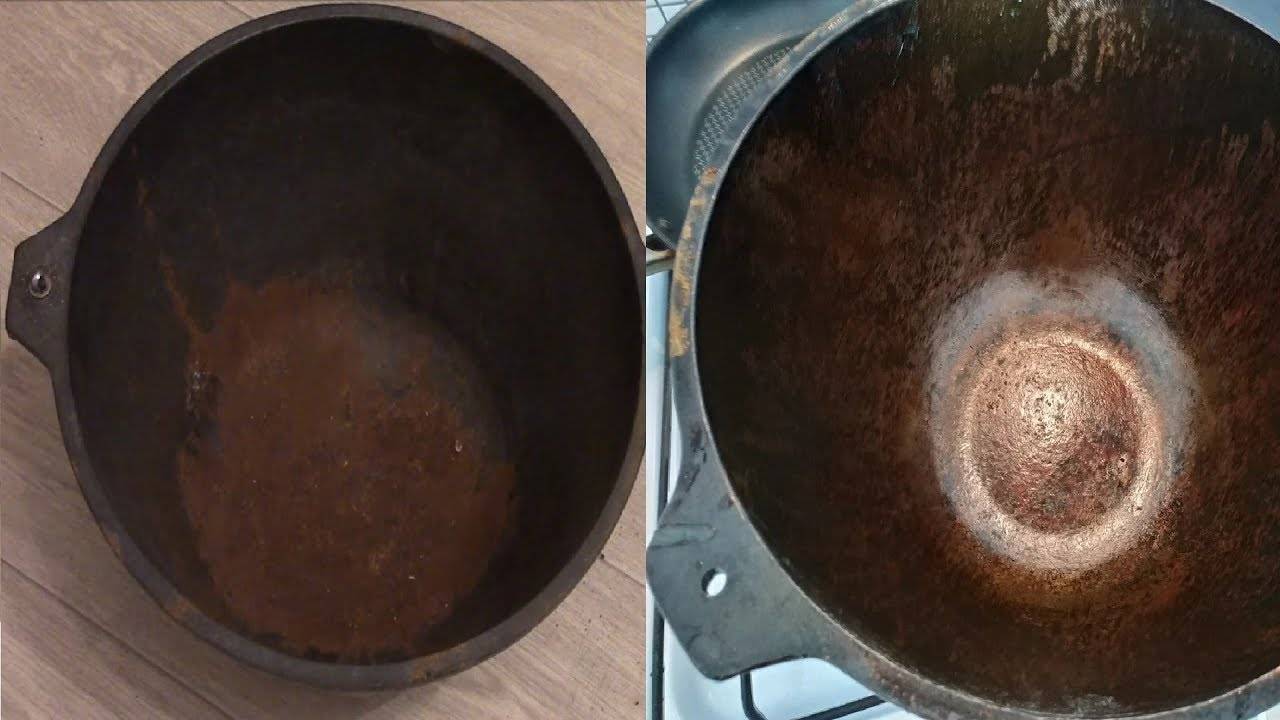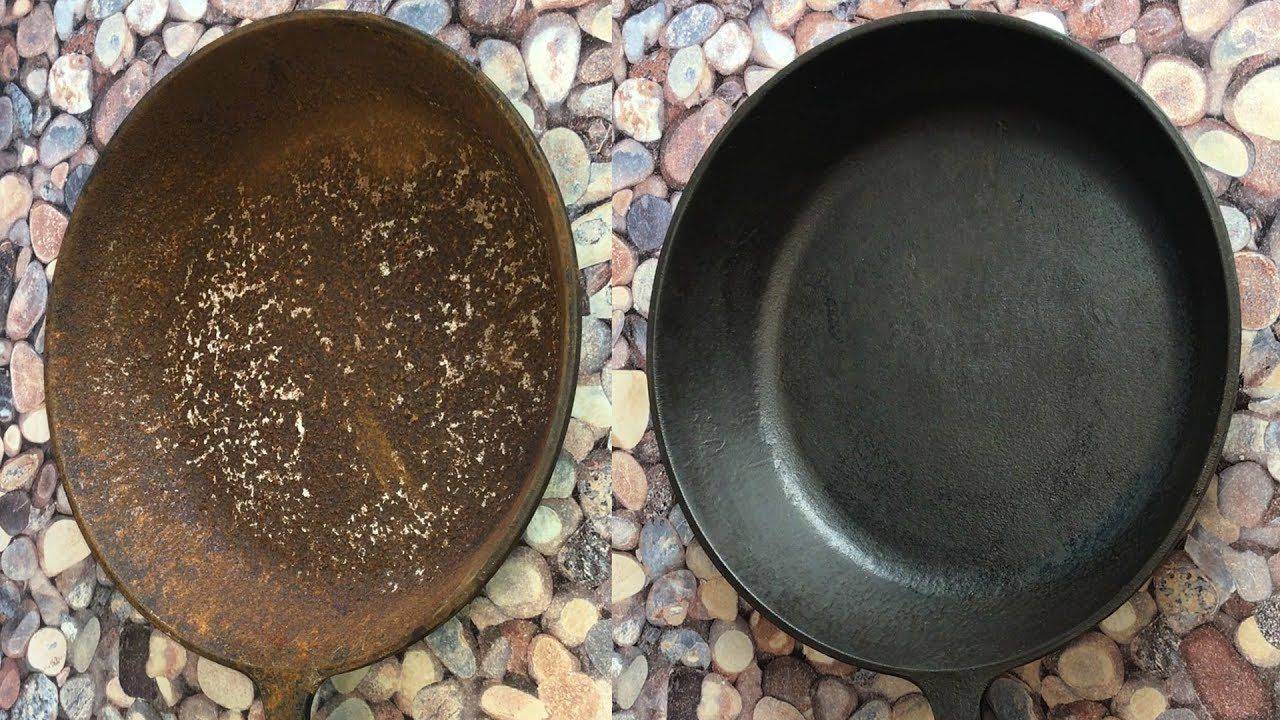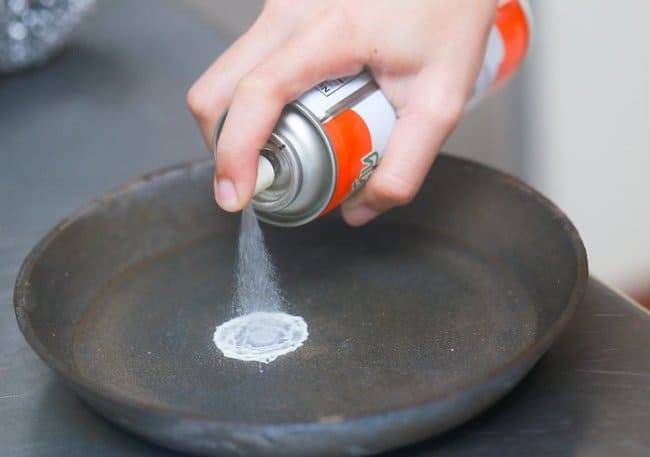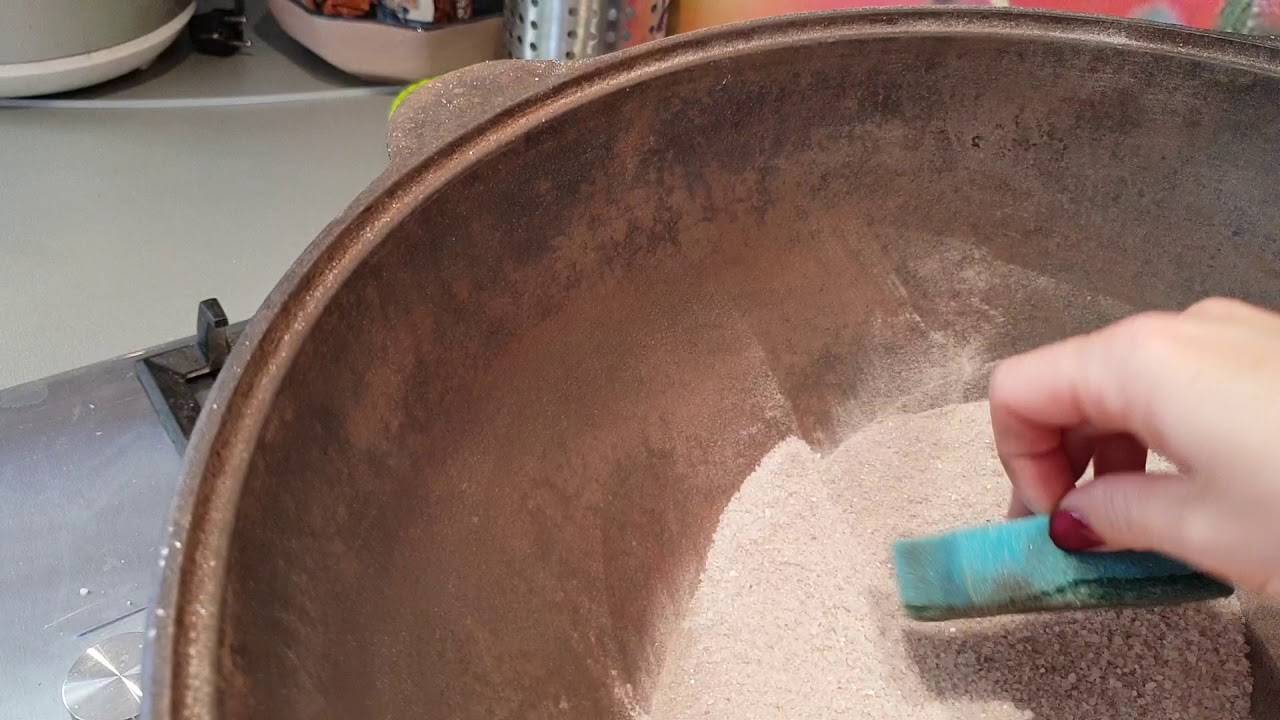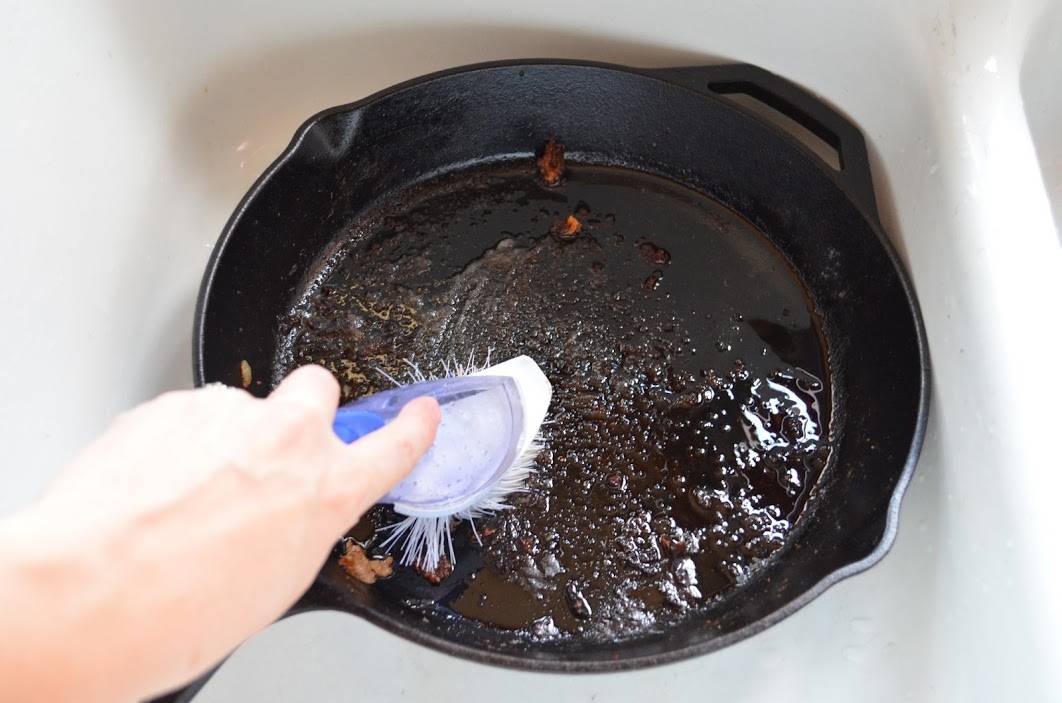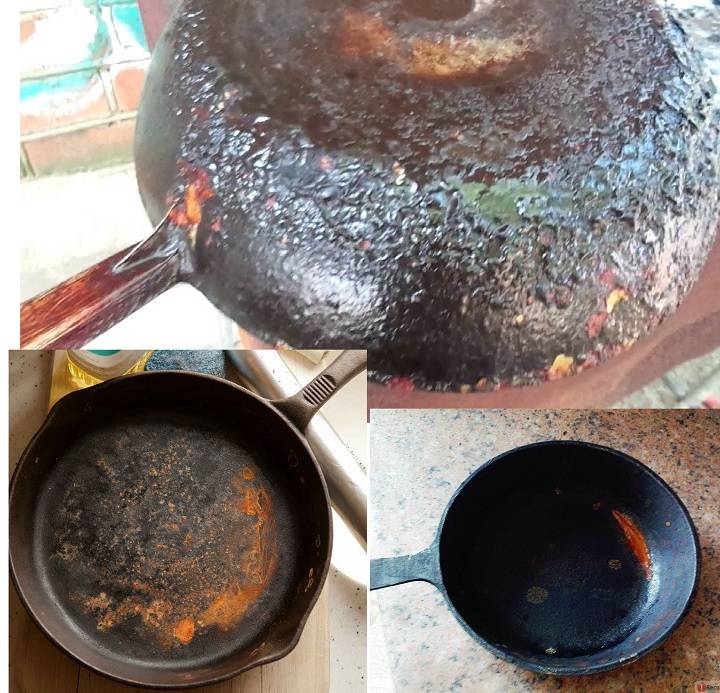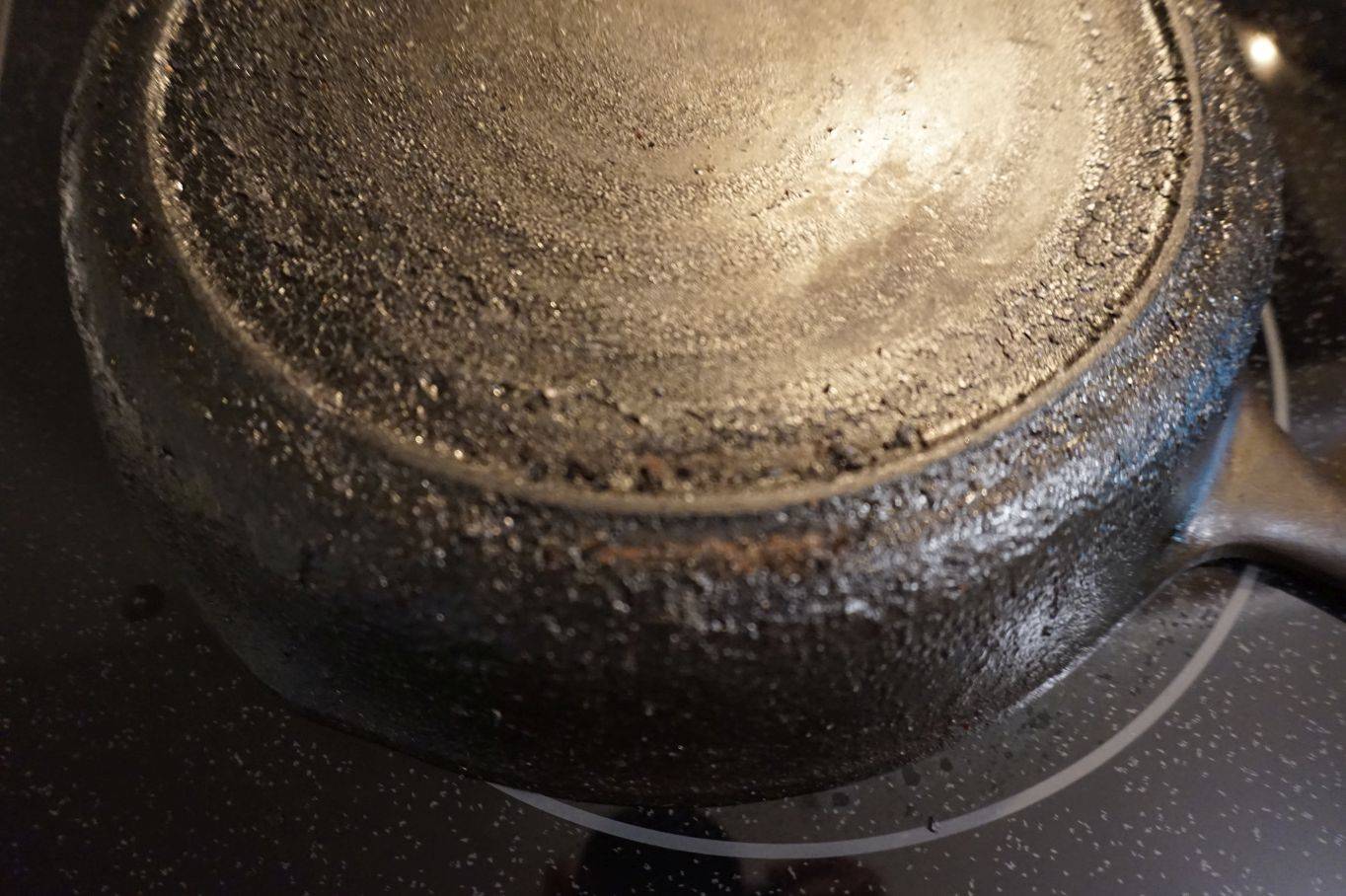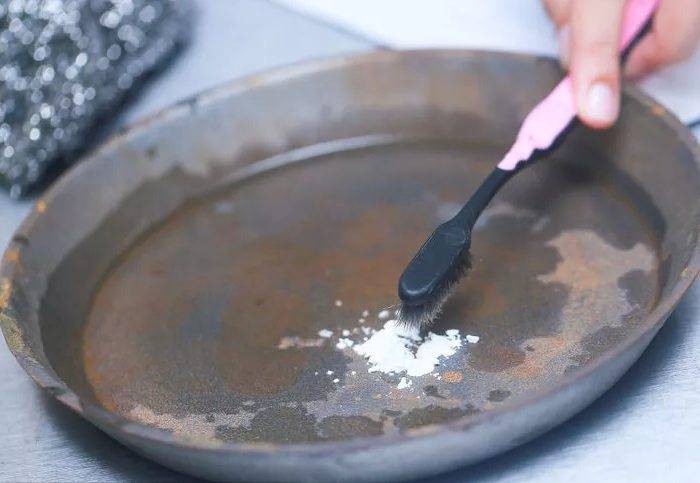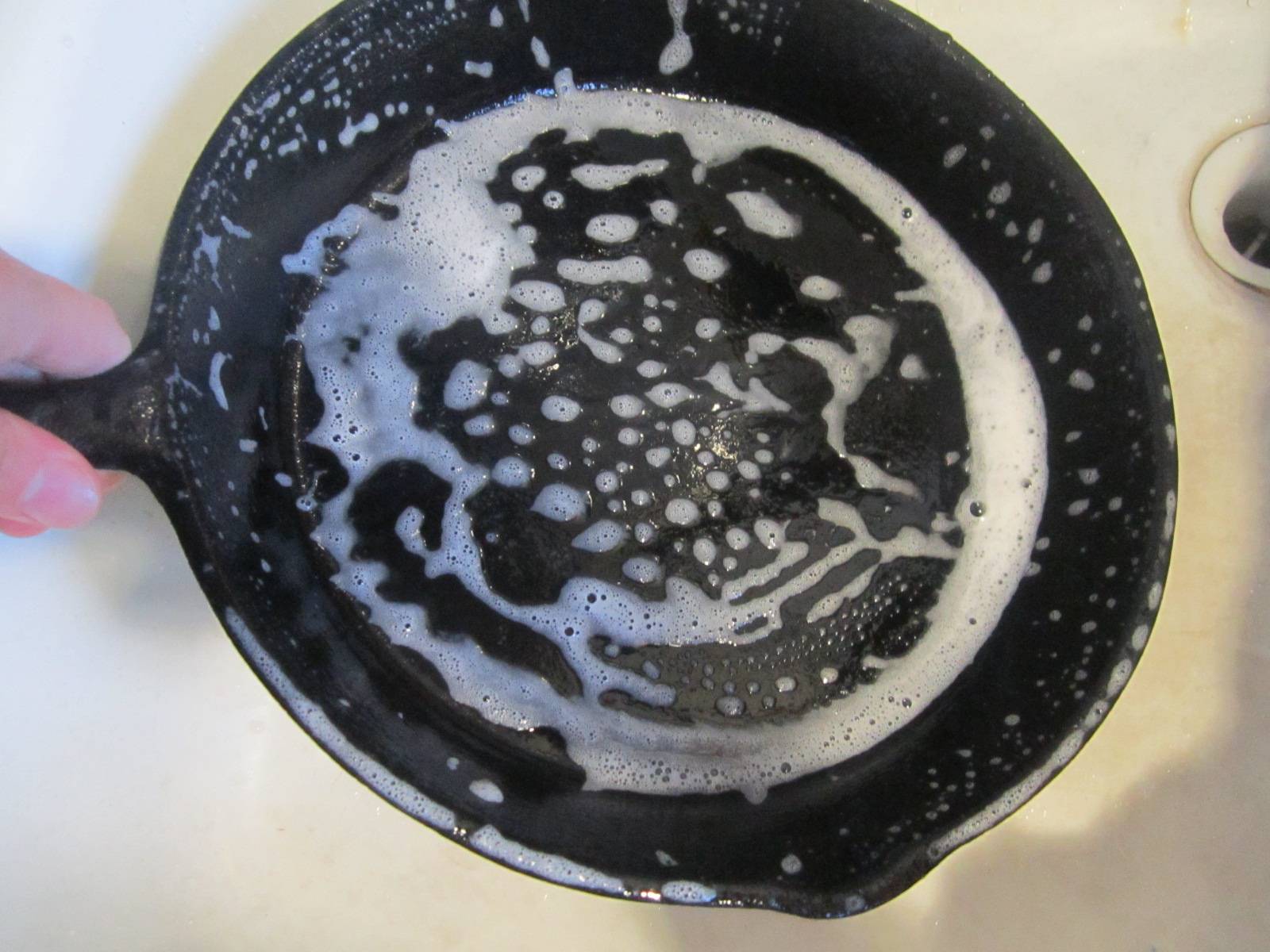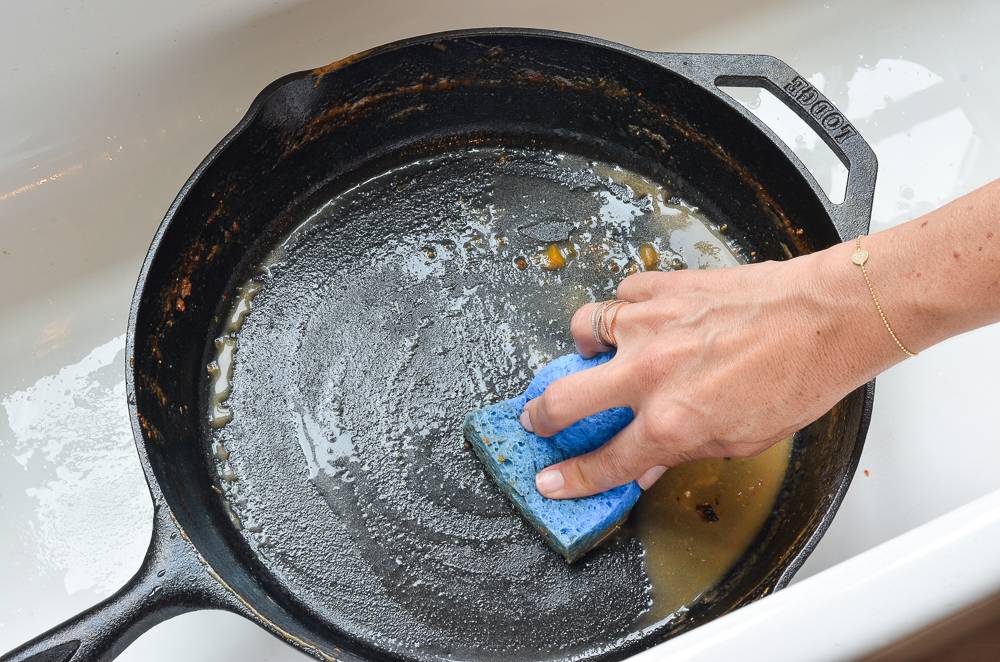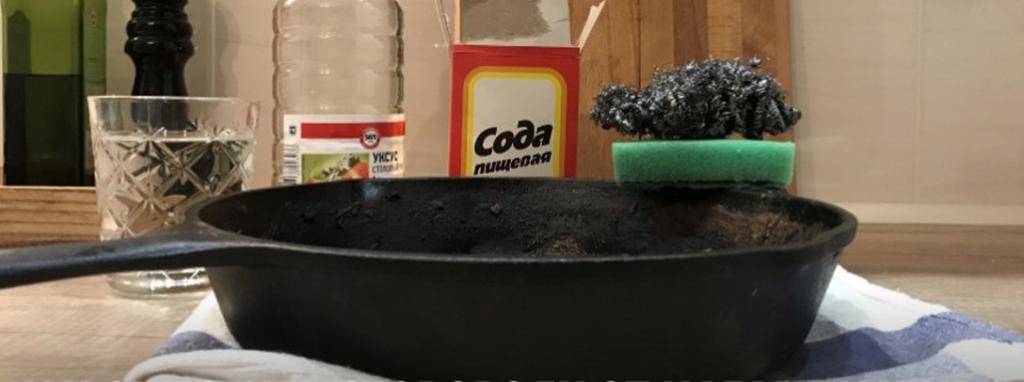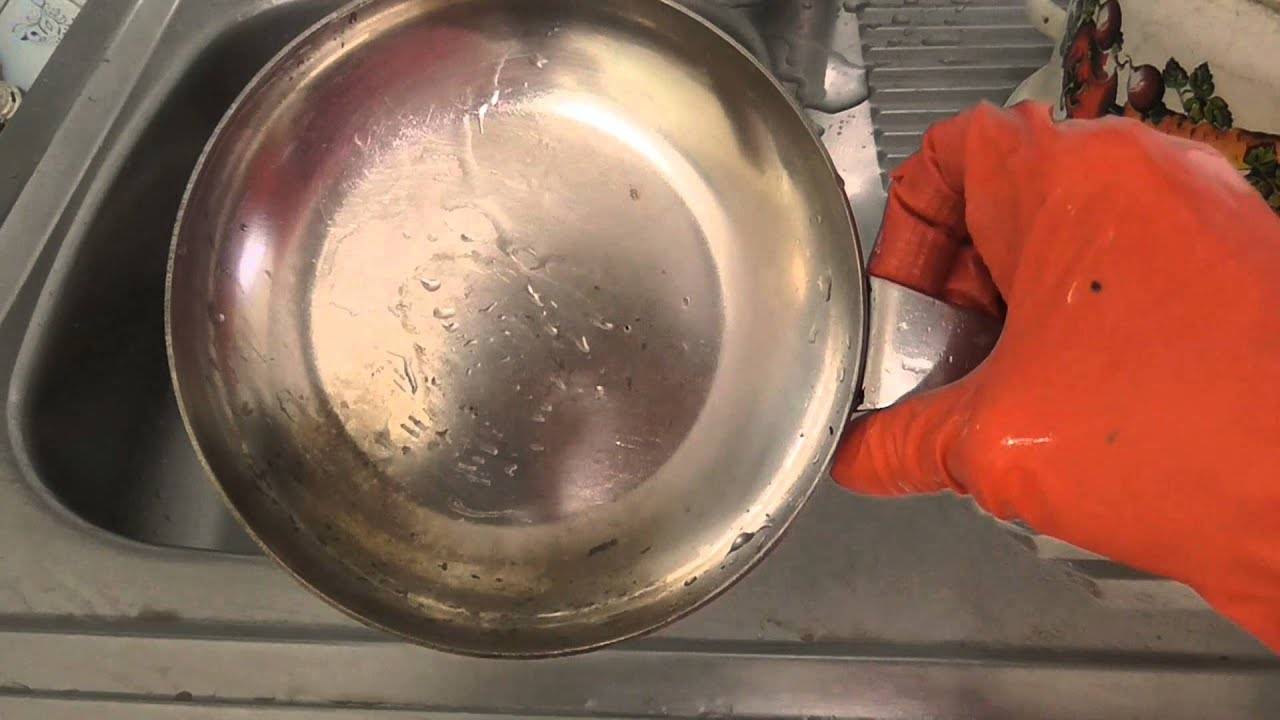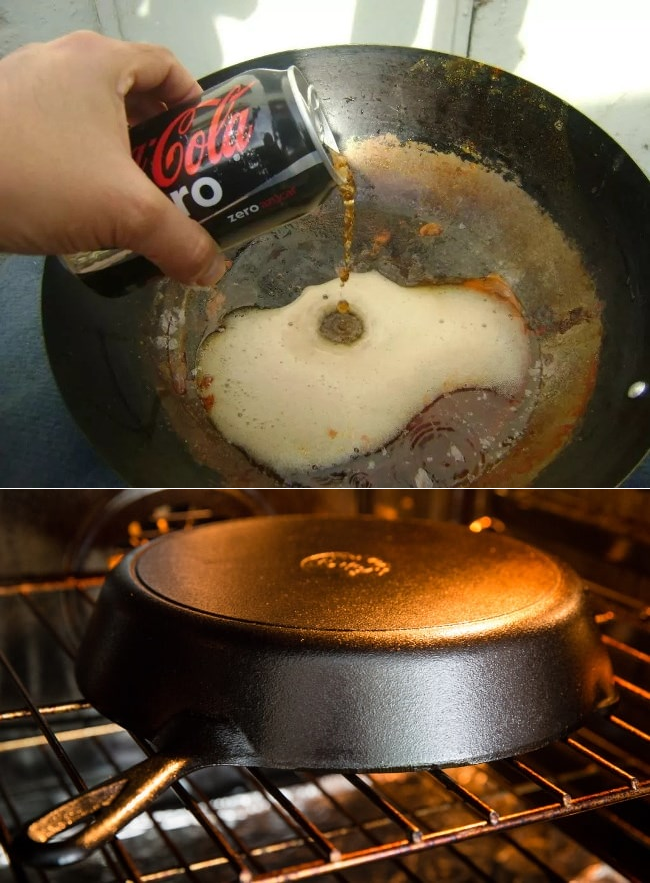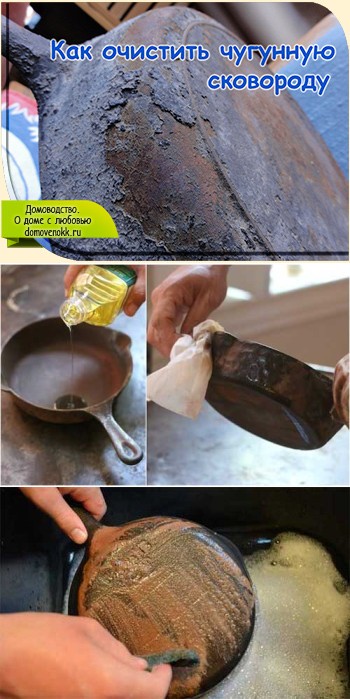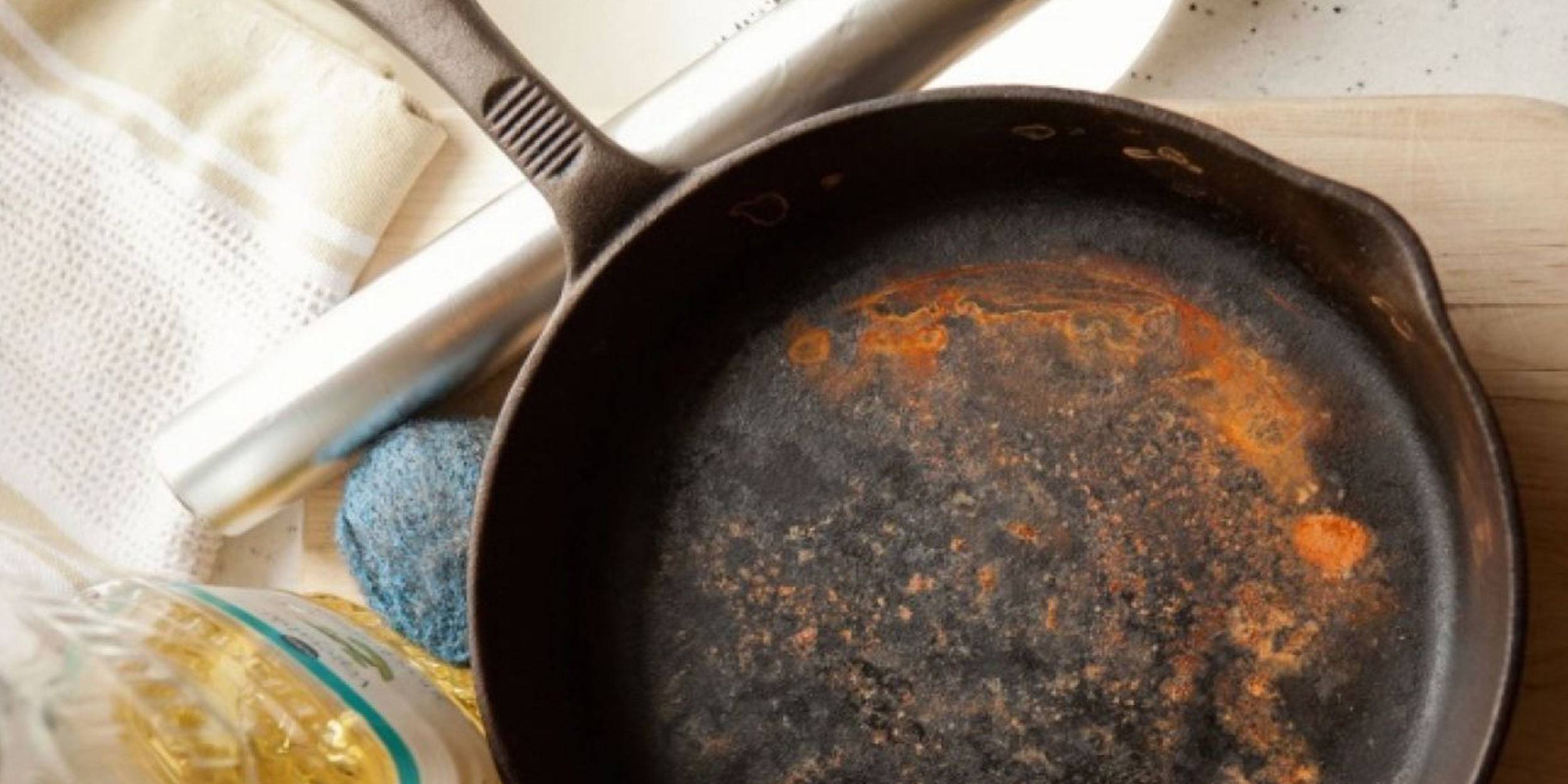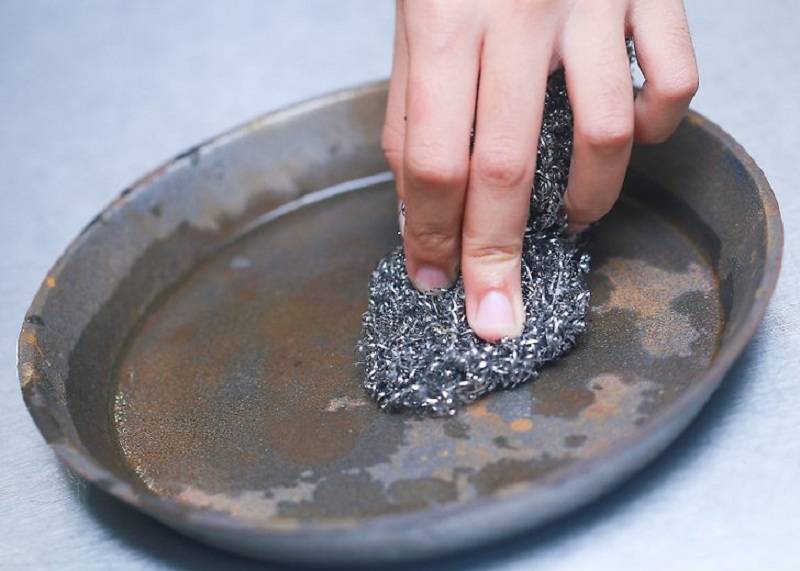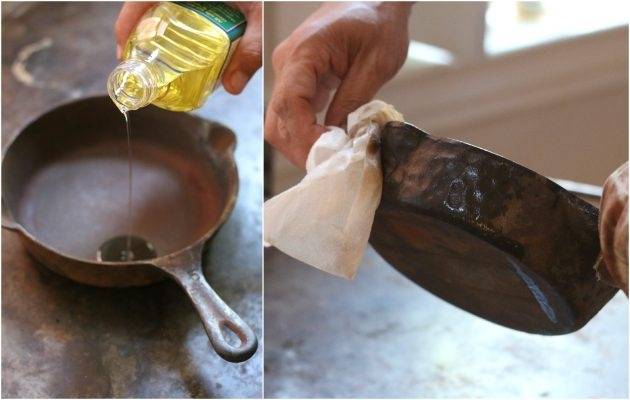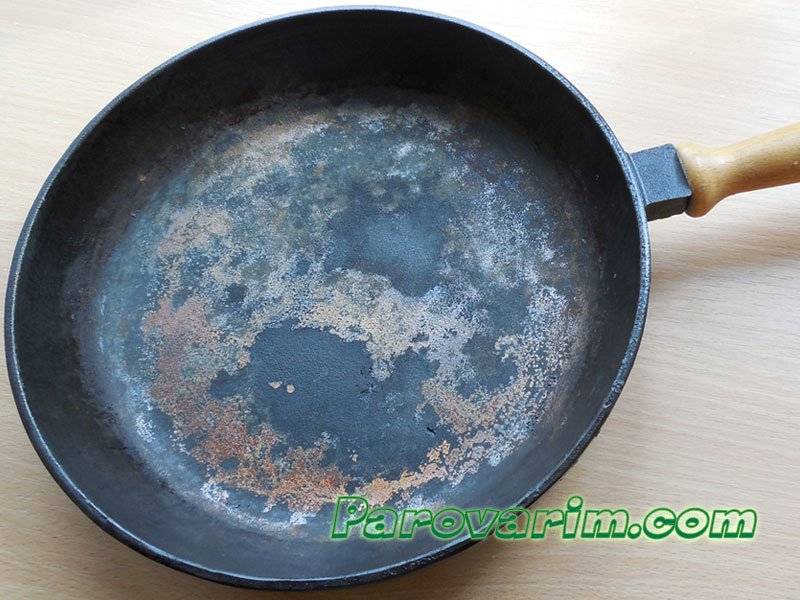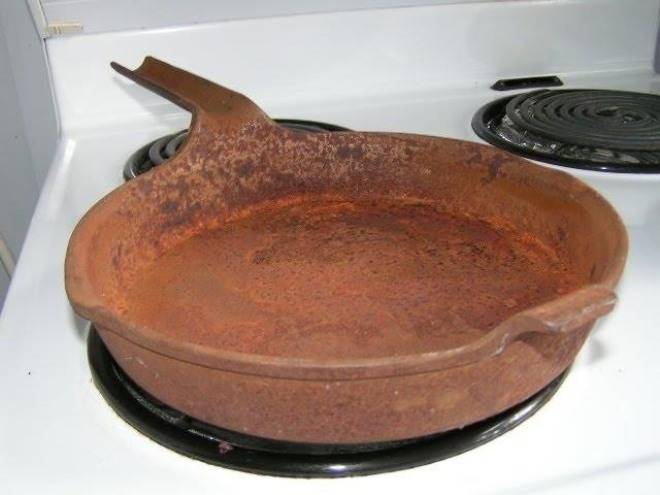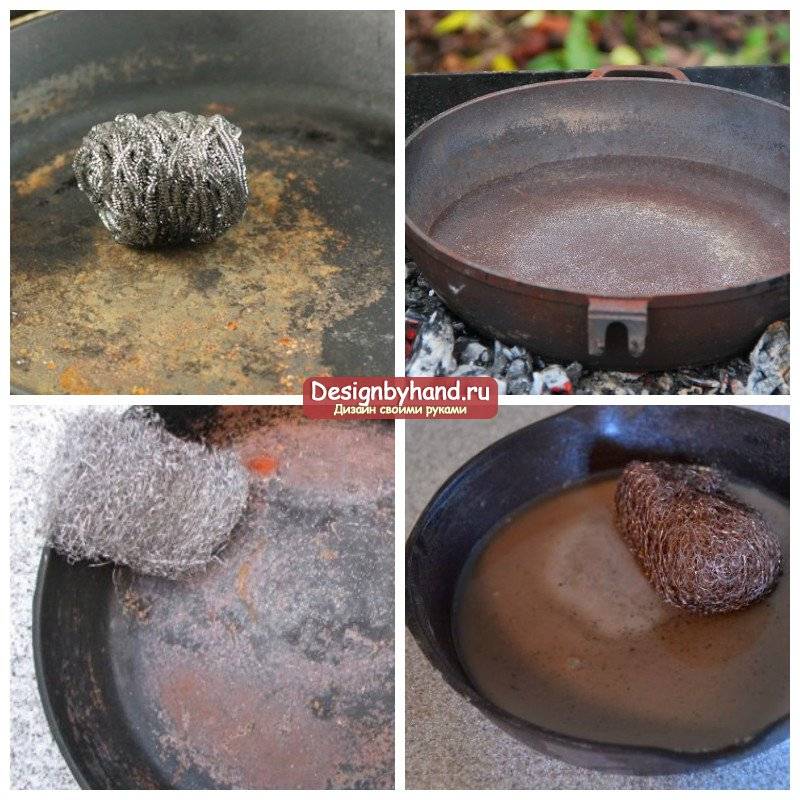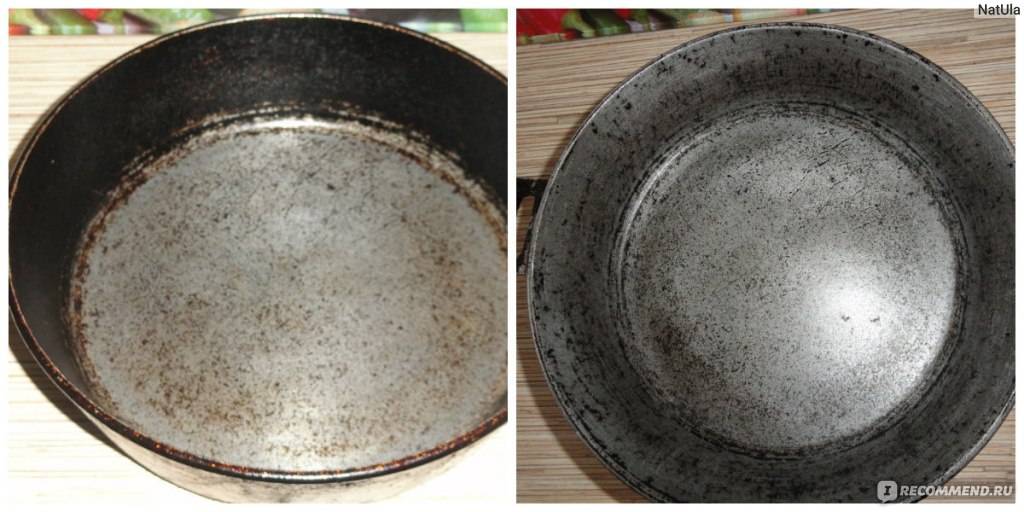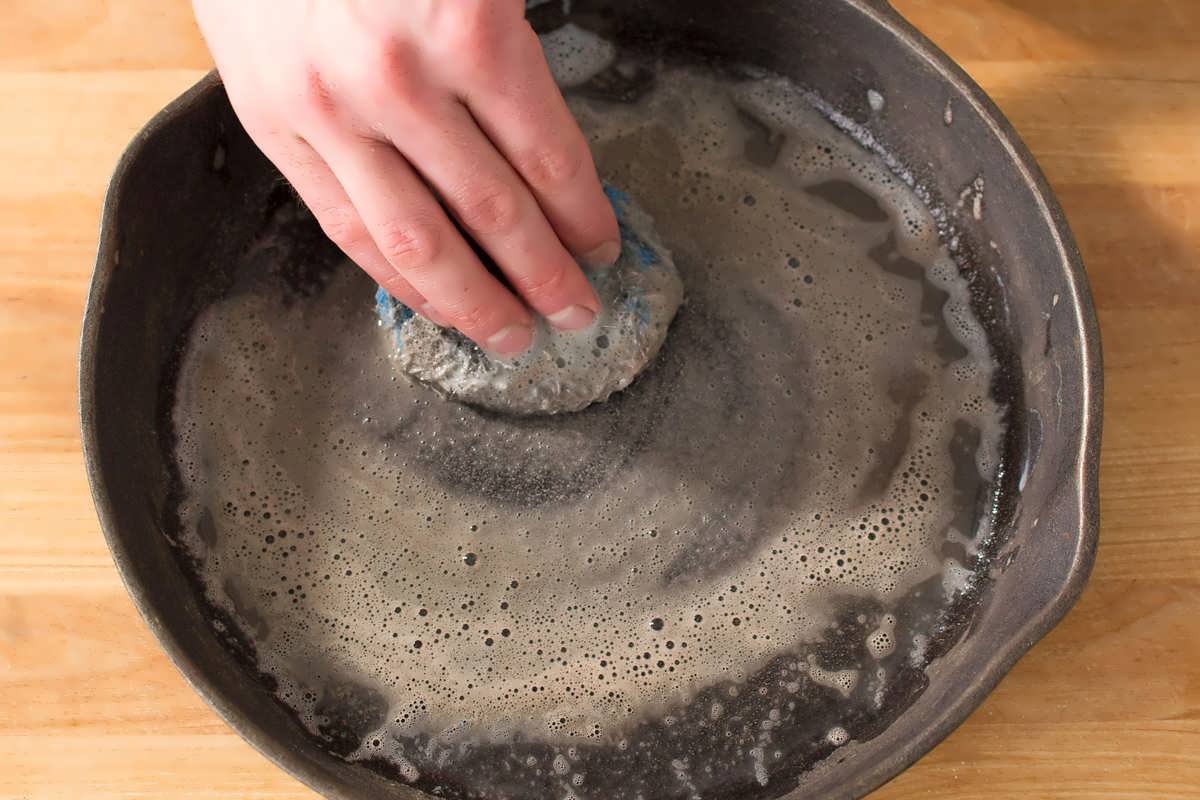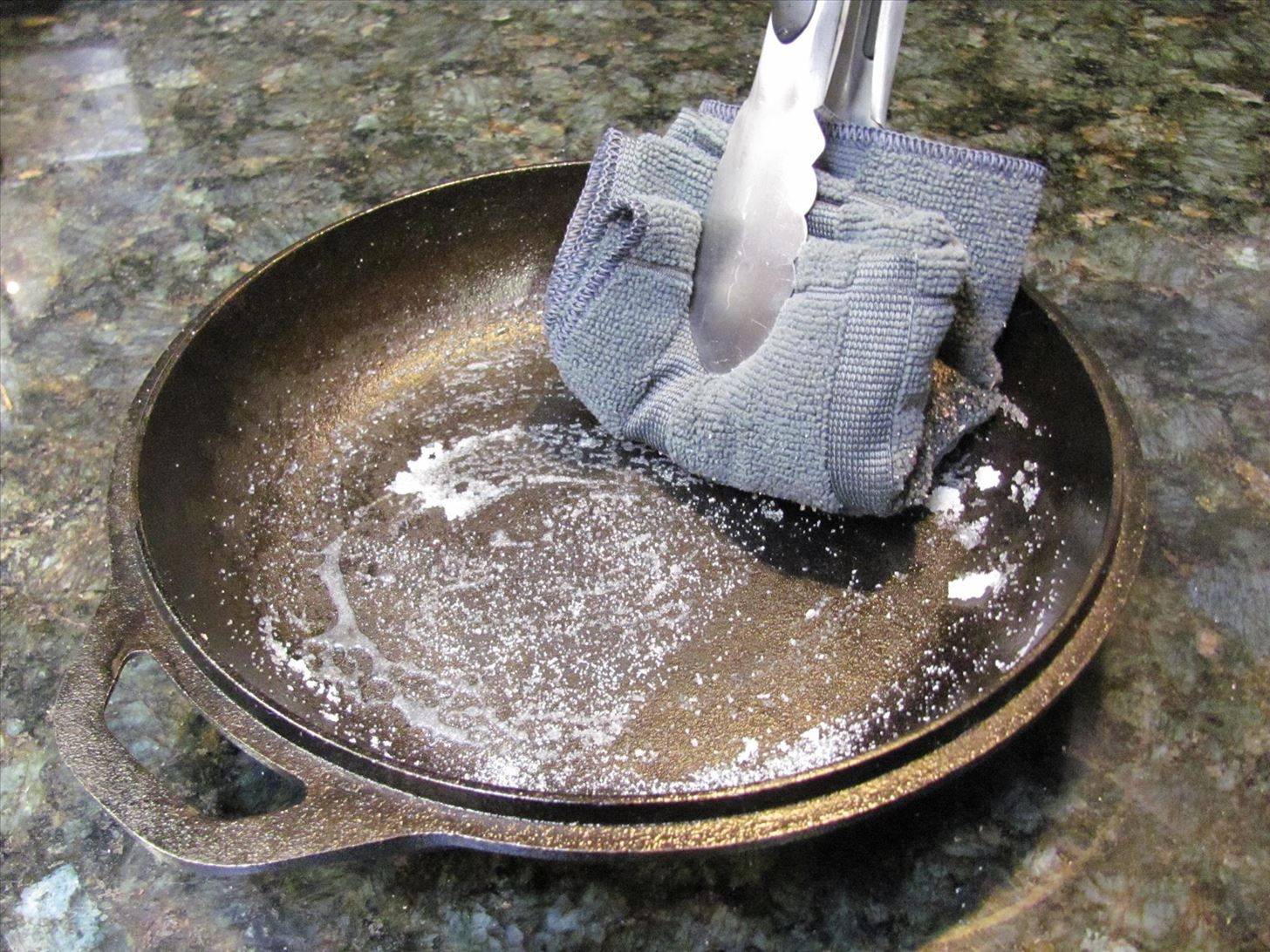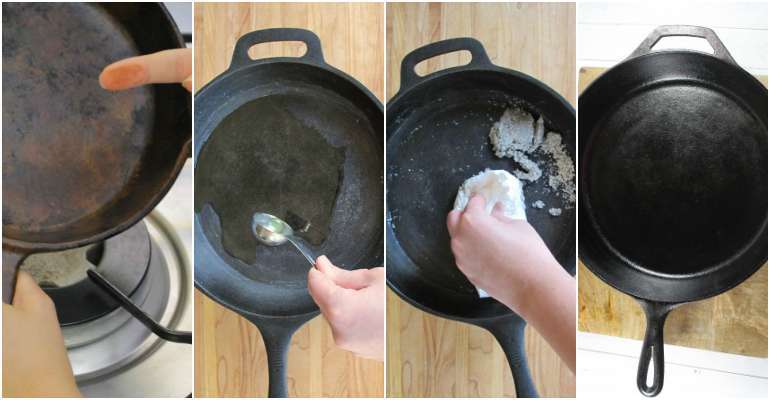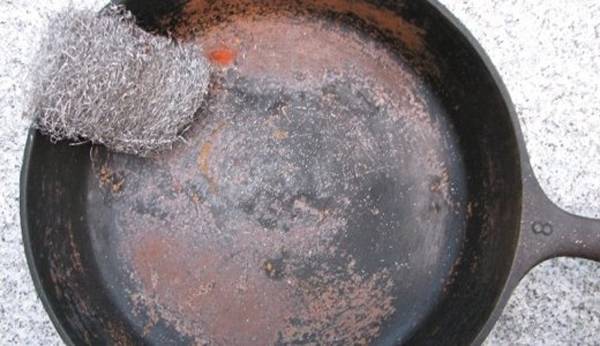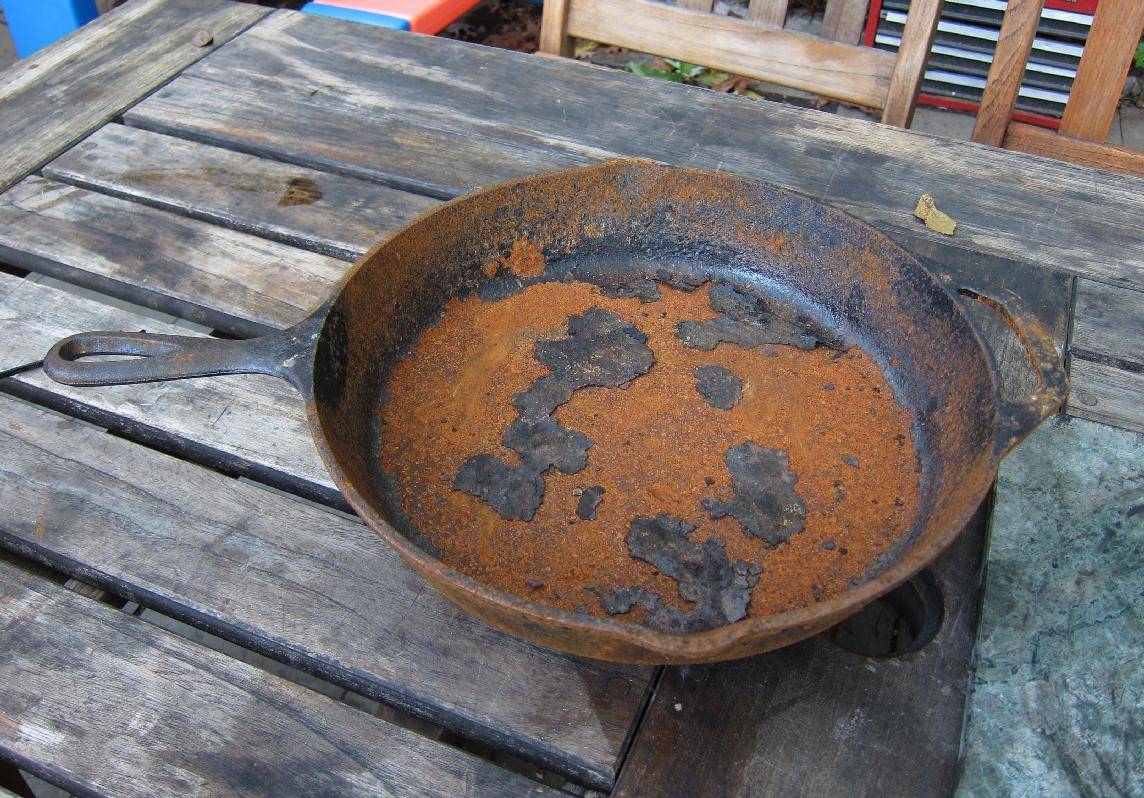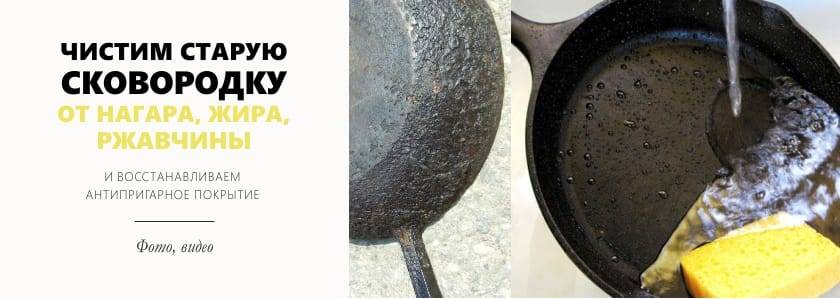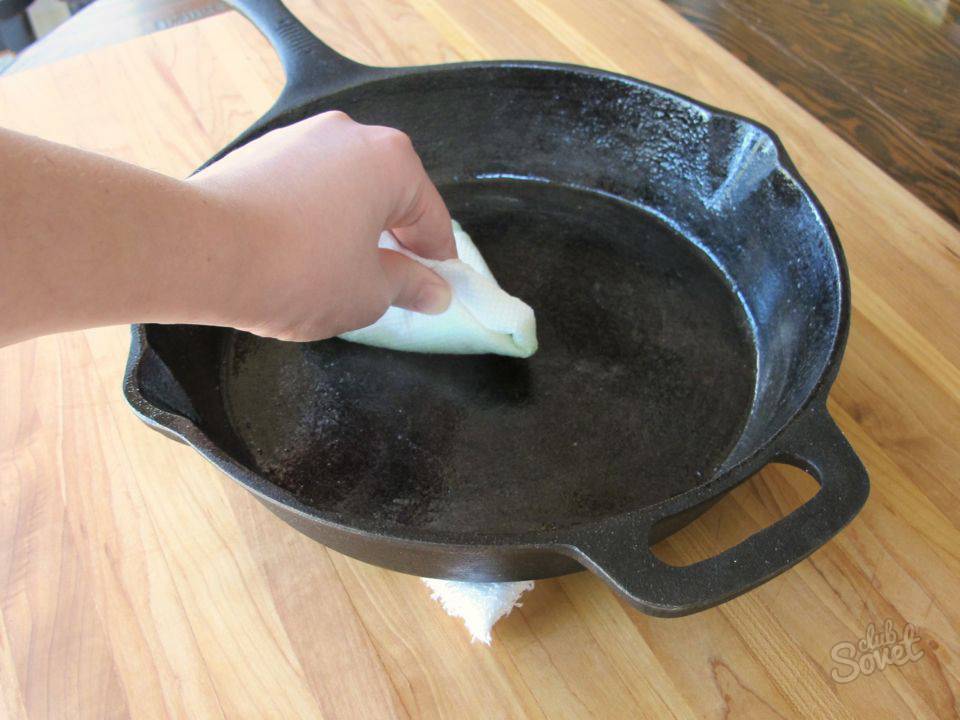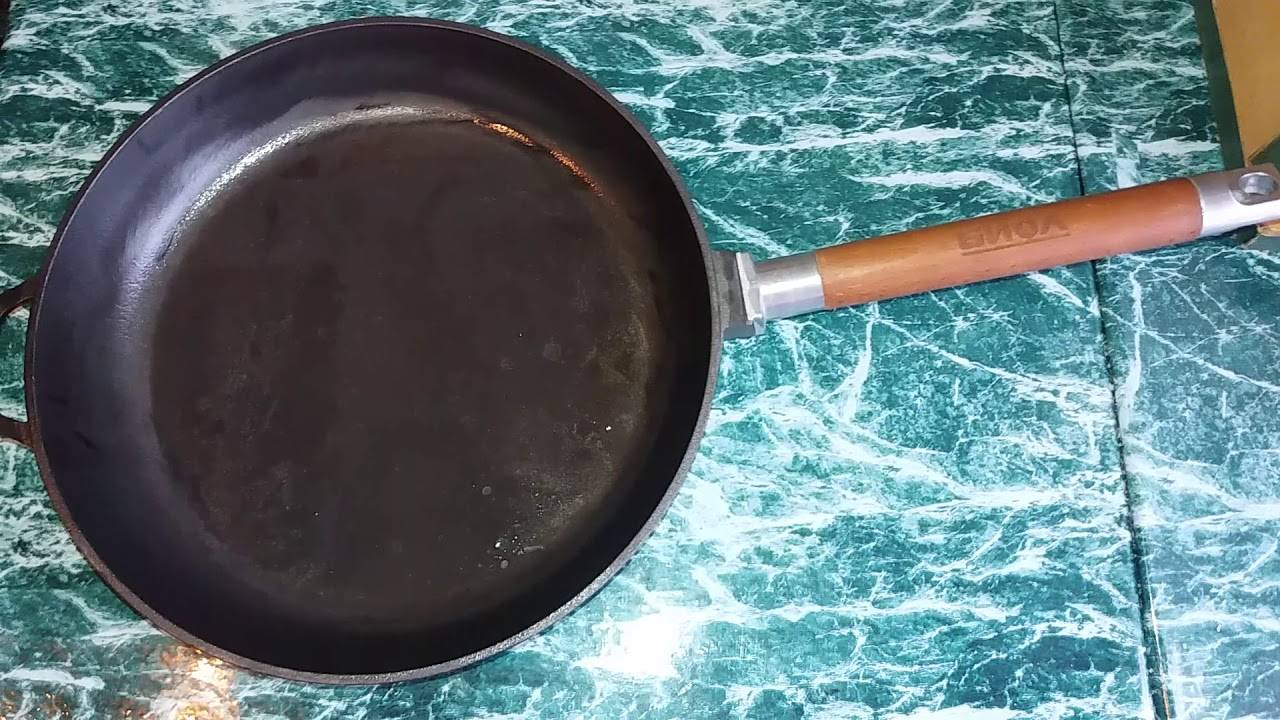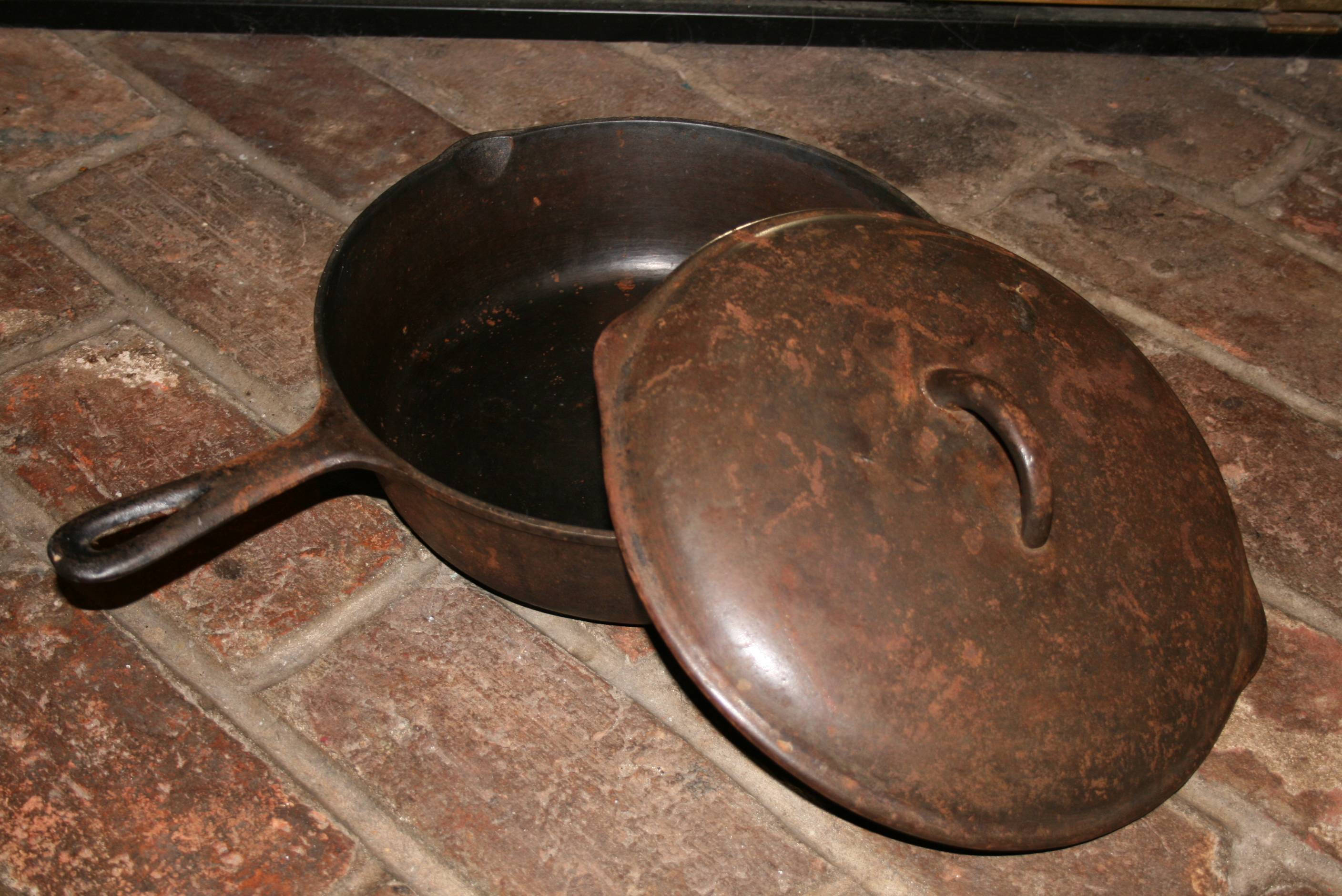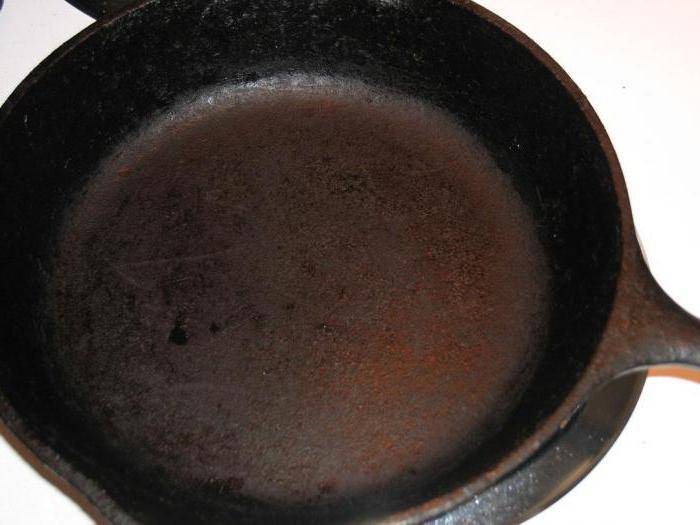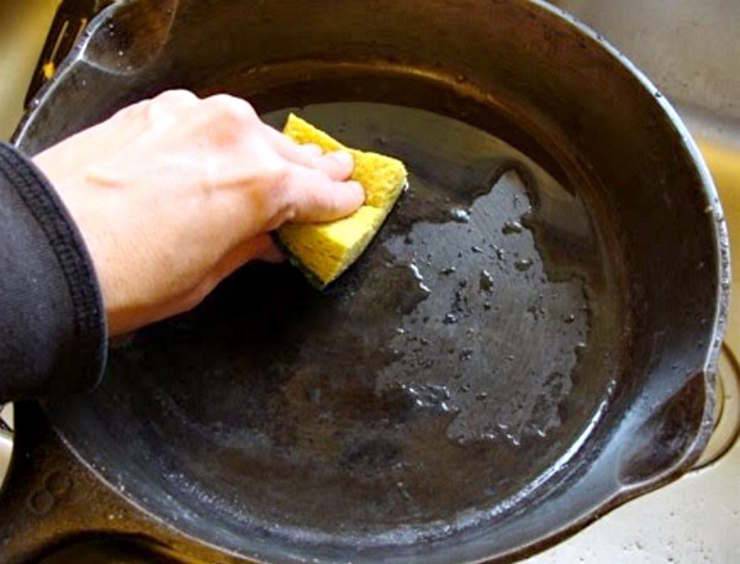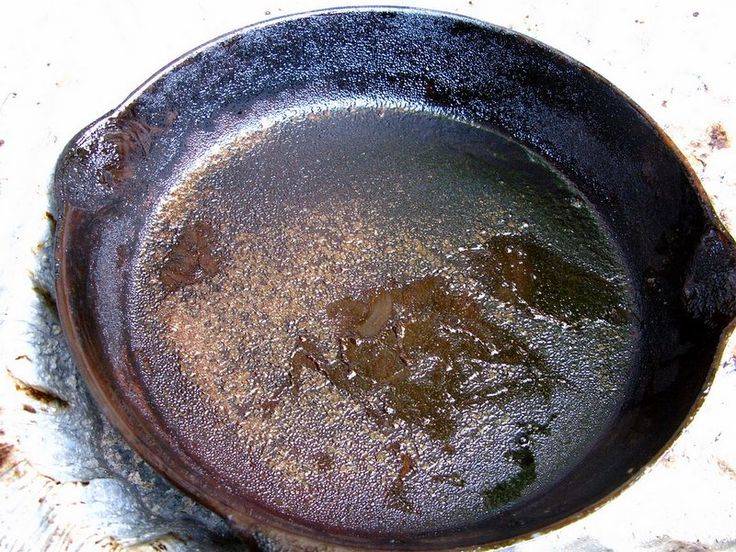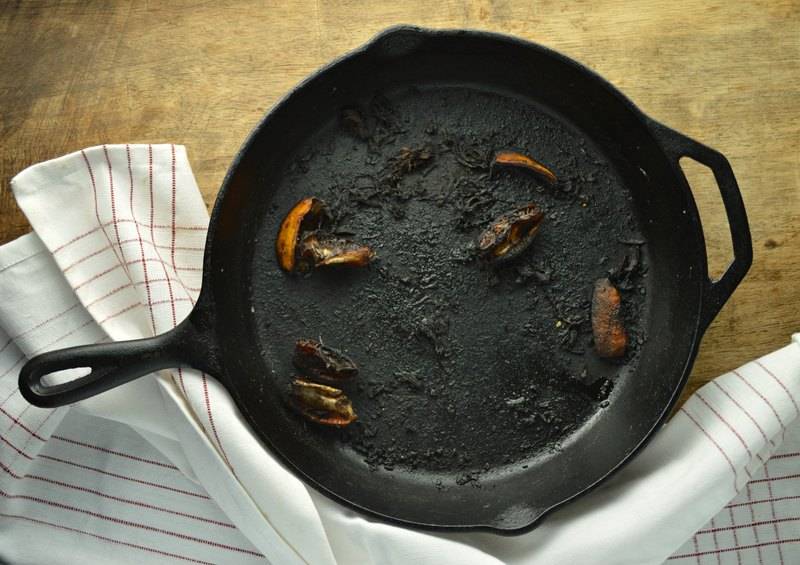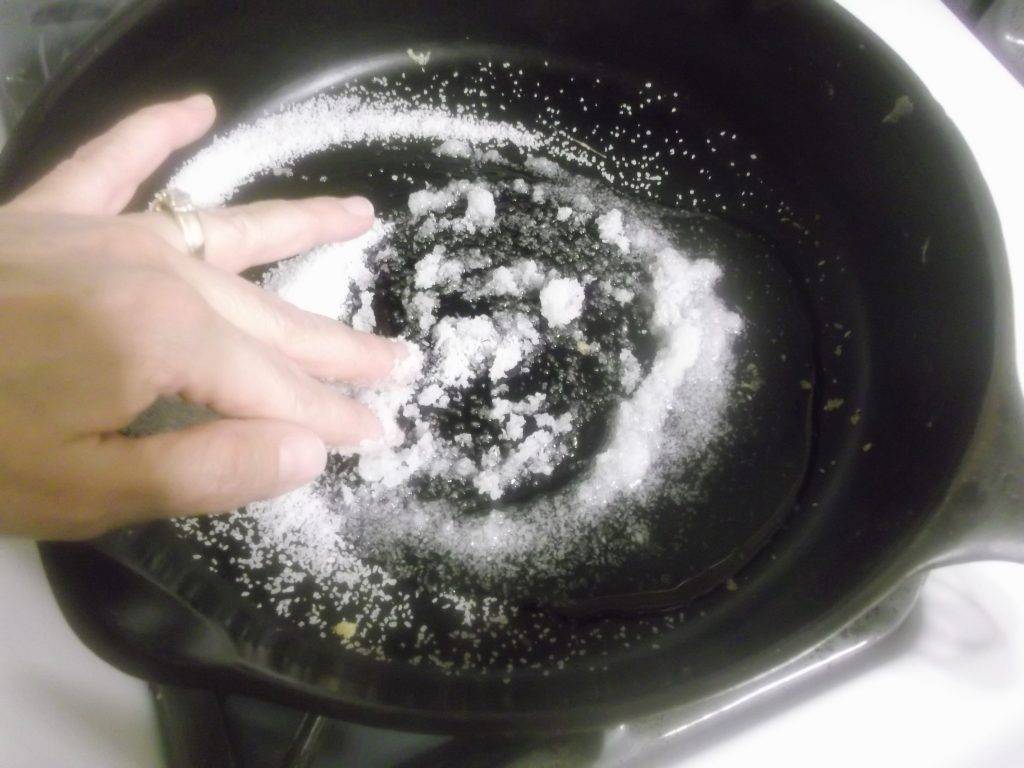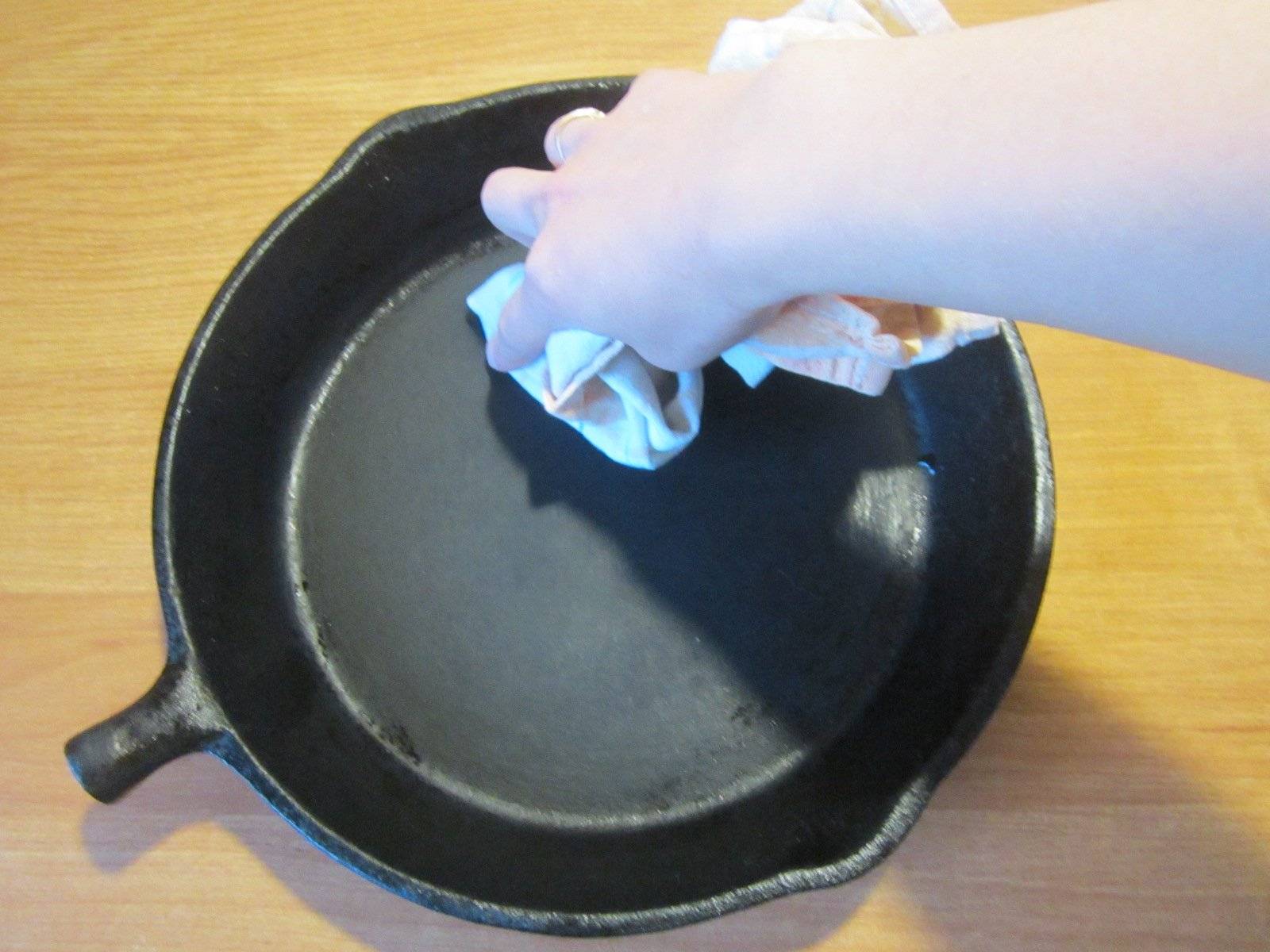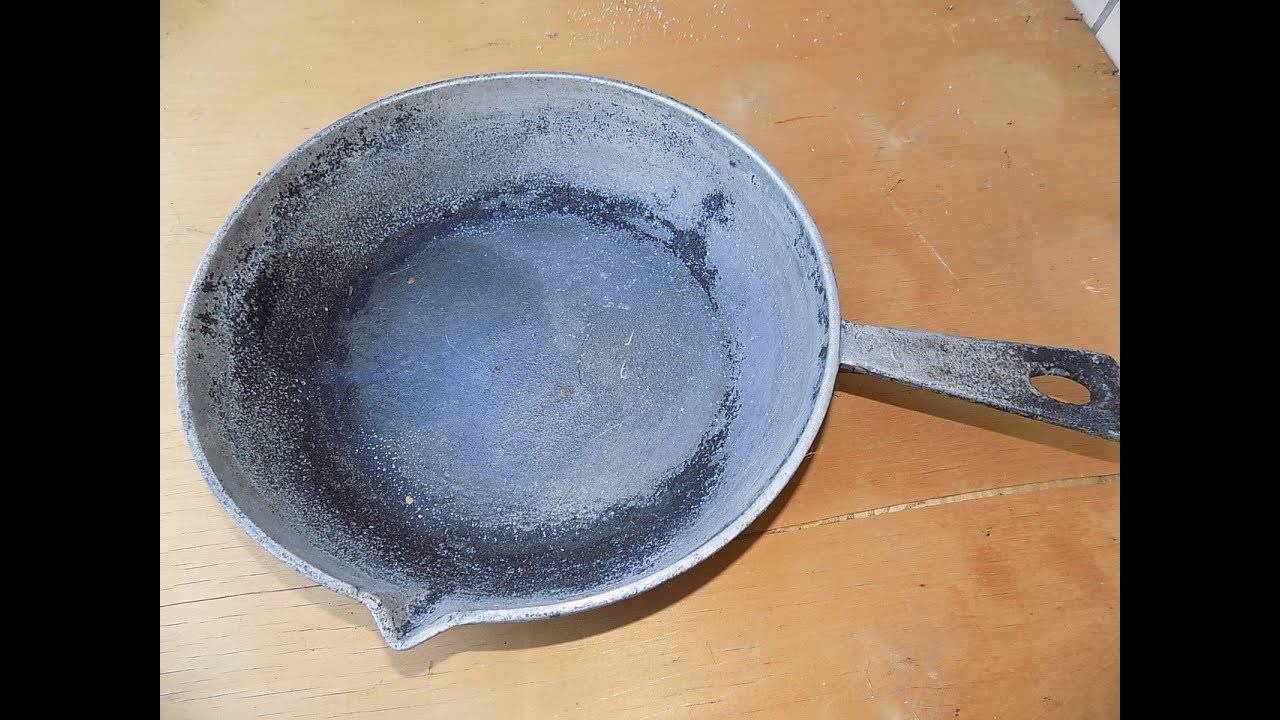Video
To get acquainted with the nuances of cleaning cast iron dishes from corrosion, it's time to watch the videos presented:
About the author:
Found a bug? Select the text with the mouse and click:
Do you know that:
Fresh lemon is not only suitable for tea: clean the dirt from the surface of the acrylic bathtub by rubbing with half a cut citrus, or quickly wash the microwave by placing a container with water and lemon slices in it for 8-10 minutes at maximum power. The softened dirt will simply be wiped off with a sponge.
Create a protective layer
How to restore the integrity of the frying pan so that no rusty stains appear. Before the first use, it is necessary to create a protective layer on the surface. This should also be done after cleaning the rusty cast iron skillet. The layer will prevent the pan from rusting in the future. The procedure should not be abandoned; the quality of food preparation depends on it. Over time, the natural layer will grow and thicken, so cooking is a pleasure. The food does not stick, it roasts quickly and evenly.
First, wash the pan under hot water. There is no need to add detergent during washing. When ignited, the dishes are completely disinfected. Do not use a dishwasher. Wipe off the factory coating thoroughly. Then wipe the pan dry, otherwise water droplets will rust again.
Cast iron has a porous structure, so the pores need to be filled with oil. When calcined, it will turn into a non-stick coating. The oil must be refined and odorless. It is best to use olive or flaxseed oil. They create a very strong film that will not break off and will not release harmful substances. You will also need salt, preferably stone.
Annealing on the stove:
- Cover the pan with a thick layer of salt and set it on high heat;
- Stir the salt until it turns brown. Salt absorbs all harmful substances, oils and dirt. This process takes about half an hour on average;
- Then add salt and rinse the dishes under hot water, do not use detergents. Dry her.
Dip a sponge or napkin in oil and grease the entire surface of the pan. Then pour the oil into a bowl and place over medium heat. Calcining will take 20-30 minutes. Then pour out the oil, wash the pan and dry it.
Roasting in the oven is the second method, more difficult, but more effective. Take measures to protect against corrosive smoke first. Since the procedure will take place in the oven, gloves should be worn so as not to burn yourself.
- Place an empty skillet on fire and keep it over medium heat until it turns gray. Pour hot metal with cold water, then pour it out. And dry the dishes;
- Next, fill it with salt, as in the first method. Fry until dark;
- After the salt has absorbed the dirt, grease the entire pan and lid with plenty of oil using a sponge;
- Place foil on the bottom of the oven, as oil will drip from the pan. Preheat to 180 degrees. Place the upside-down skillet in the oven for three hours.
Before the first cooking, it is advisable to repeat the procedure so that the layer hardens. If cracks or chips appear on the product, this is a sign of low-quality metal that does not meet the requirements. Cast iron is not afraid of high temperatures. It is best to get rid of a cracked frying pan.
 Rub the coating with vegetable oil
Rub the coating with vegetable oil We heat the oven 180 degrees
We heat the oven 180 degrees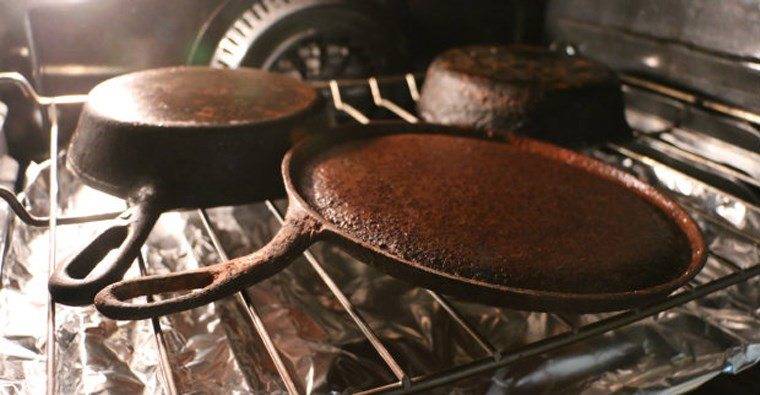 We put in the oven
We put in the oven
How to clean grease from glassware
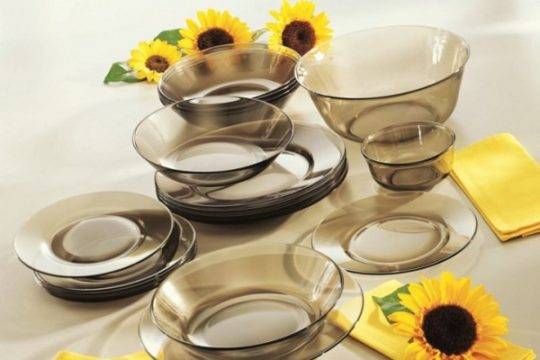
Glassware is quite common in modern kitchens. Glass does not react to food, does not decompose from acids and scale, is not afraid of rust and does not absorb odors.
But the care of such dishes should be special. You can clean glass kitchen items using one of the following options.
- Food foil and soap. Take a piece of this material and crush it. Keep the dishes under running hot water and rub at the same time with foil. Then it will remain to wash off traces of fat with a soapy sponge. At the end, the dishes will remain to be rinsed in heated water and wiped off.
- Ammonia. Pour 5 liters of heated water into a basin, and then another 5 tsp. ammonia. After washing the dishes in such a solution, they are wiped dry with a flannel cloth without rinsing.
- Mustard powder. Pour 3 liters of heated water into a basin and pour 2 tsp into it. mustard powder. Soak glassware in this liquid composition for 7 minutes. Remove the dishes from the basin, dry them with flannel and rinse with water.
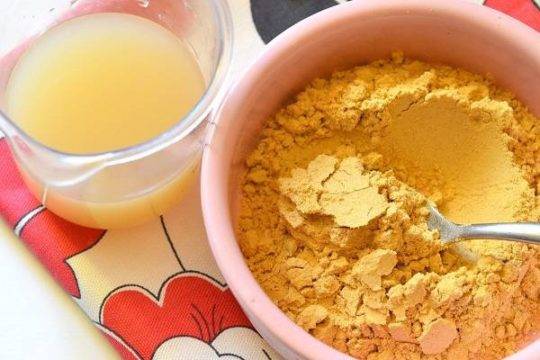
- Table vinegar. Pour heated water from the tap into the sink. Add 2 tbsp. l. 9% vinegar. Wash the dishes in this solution for 2 minutes. Dip the dishes in water and dry them.
- Eggshell. The shell of chicken eggs helps to effectively free glass items from carbon deposits or plaque. Crush the material into a powder and add soapy water to the dirty dish. With this mixture, you can easily scrub the walls of the dishes.
- Potato chips. If you need to clear a glass bottle or jar of grease and dirt, then this is easily done with potato chips. In terms of application, this method is very similar to the previous one.
- Baking soda. Place the dishes in heated water. Sprinkle a pinch of baking soda on a sponge moistened with water. Wipe the dirt until the result is achieved. Dip items in water and dry.
- Salt. Washing such dishes in salted water does not lead to streaks and returns shine to the items. Pour 3 liters of heated water into a basin. Dissolve 3 tbsp in liquid. l. salt and stir the composition. Wash the glassware with the solution, then dry without wiping.
3 Application of non-stick coating
So that during further operation the cast iron dishes are not covered with rust, they must be calcined in the oven, having previously greased with vegetable oil - sunflower or linseed. Such processing not only protects the product from corrosion, but also gives it non-stick properties, as a result of which the food will not burn, and the cooked dish will seem tastier. Procedure:
- Before baking, grease the cast-iron surface with refined vegetable oil. 1 tablespoon is enough to process a medium to large frying pan - oil should not drip or drip from the walls.
- Heat the oven to 190-200 degrees and put the cast iron product inside, placing it upside down on the middle wire rack.
- Ignite the dishes for 1-1.5 hours, then turn off the oven, open the door and wait until the metal has completely cooled down.

Creating a non-stick coating is a reliable way to protect the pan from corrosion and food scorching.
The dishes processed in this way will be covered with a thin oily “tan”: the vegetable oil will spread evenly over the surface, “absorbed” into the micropores of the cast iron and will take the form of an invisible protective film. It will prevent food from burning during cooking and will also prevent rust stains as water and food particles cannot come into contact with the metal.
In the future, it is not difficult to properly care for a cast-iron pan: do not load the product into the dishwasher, do not use aggressive cleaning agents, wash with hot water, wipe dry with a paper or cloth towel and store in a dry place.
1 Methods for removing rust
Having found rusty spots on the surface of a cast-iron frying pan, cauldron or ducklings, you should use an affordable folk remedy:
- Dilute 9% table vinegar with water in equal proportions.
- If there is rust inside the pan, pour the solution into the pan to such a level that the damage is covered with liquid.
- If corrosion has also spoiled the outer surface of the pan, immerse the dishes in a large container (basin, boil) and completely fill with vinegar solution.
- Leave the pan for 6-8 hours, then drain the liquid, wash and dry the cast iron product.
For a light coating of rust, this may be enough, but if yellow-brown spots remain on the metal, you need to sprinkle coarse table salt on them and rub the potato cut over the surface: salt will play the role of an abrasive material that can remove the microscopic top layer of rusty coating, and potatoes will give the required amount of juice.
You can use another cleaning combination: mix in a 1: 1 ratio of table salt and vegetable oil, apply the mixture to rusted areas and rub with the hard side of a kitchen sponge.
In advanced cases, when the old frying pan has been in a damp place for a long time (basement or shed), you will have to resort to brute force and apply a manual or electric grinding method. In this case, you will need:
- scouring powder for dishes or sanitary ware and a sponge with a hard surface;
- a metal kitchen scrubber or brush;
- medium grit sandpaper.
These items should be applied in the sequence shown to achieve the desired result.
You can remove rust from a cast-iron frying pan or cauldron with the help of carbonated drinks: Coca-Cola, Sprite, Fanta and others. They contain orthophosphoric acid, which is part of many store-bought preparations for cleaning dishes and plumbing fixtures. The drink must be poured into a bowl, boiled on the stove and left for 8-12 hours, preferably overnight, and then rinsed with clean water.
There is another way by which you can clean the cast-iron surface from rust - by boiling it with salt. It is the safest, but also the longest in time:
- put a frying pan in a boil or a spacious bowl and completely fill it with water;
- add table salt to the container at the rate of 1 glass for each liter of water;
- put the boil on the stove and bring the water to a boil;
- reduce the heat and boil the cast-iron utensils for at least 8-10 hours, adding clean water from time to time so that the pan is constantly in the water.
It is more convenient to start the digestion procedure in the morning, then by the evening it will be possible to drain the dirty liquid and wash the product.
How to burn a cast iron pan?
Create a protective layer using the oven and oil. 1. First, preheat your oven to about 177 degrees Celsius. The point of firing is that you practically "bake" a protective layer of fat on the surface of the cookware. So, while the oven is preheating, it's time to do the following preparations.
2. Thoroughly coat the inside of the pan with vegetable oil. Simply pour it into the skillet and spread it well with a paper towel. Many professionals also lubricate the outside of the pan, the bottom and the handle, which, if desired 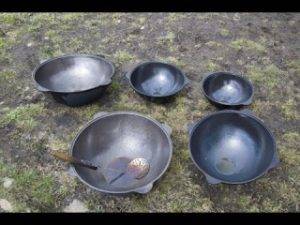 ui, you can repeat it. But this is not necessary. It is not worth firing in olive oil, as it begins to smoke at high temperatures. After all, you do not want to then remove the soot from your favorite kitchen and disturb the fire alarm.
ui, you can repeat it. But this is not necessary. It is not worth firing in olive oil, as it begins to smoke at high temperatures. After all, you do not want to then remove the soot from your favorite kitchen and disturb the fire alarm.
3. Do not be discouraged if you do not have vegetable oil on hand. Other sources of fat can be used quite successfully. Fat left in the pan after frying pork or cooking oil is perfect for these purposes. But when using them, a lower temperature is required, ranging from 135 to 149 degrees Celsius.
4.Place the skillet in the oven, placing it upside down. It is desirable that it is located exactly in the middle of the oven. Place a baking sheet underneath to drain excess fat. Leave the skillet to roast for one hour.
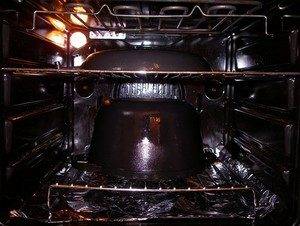 5. After one hour, turn off the oven. Do not open the oven door until it has completely cooled down. This may take about a couple of hours. When the oven, and therefore the frying pan, has cooled down sufficiently, remove the burnt frying pan using oven mitts. We can safely congratulate you - now your frying pan is not afraid of rust and burning of food! It is completely protected from external irritants!
5. After one hour, turn off the oven. Do not open the oven door until it has completely cooled down. This may take about a couple of hours. When the oven, and therefore the frying pan, has cooled down sufficiently, remove the burnt frying pan using oven mitts. We can safely congratulate you - now your frying pan is not afraid of rust and burning of food! It is completely protected from external irritants!
6. If this need arises, you can make an incomplete firing of the cast-iron pan. As before, just carefully treat the inside of it with pork or cooking oil or vegetable oil. This will be advisable if during cooking you accidentally violated the integrity of the protective layer on the cast iron pan.
Video:
With proper care, a cast iron frying pan can serve you for decades, helping to bring your favorite culinary masterpieces to life!
Special means
What to do if rust is deeply ingrained in a cast-iron frying pan? Simple substances sometimes fail to remove signs of corrosion. In this case, use strong chemicals. They contain about 30% hydrochloric acid, which dissolves rust.
Try to use only proven and high-quality chemicals, as cheap ones can be harmful to health
In any case, take precautions: hydrochloric acid is a very strong and dangerous substance
To clean rust from cast iron cookware:
- use rubber gloves when working with products;
- wear outerwear with long sleeves;
- use glasses to prevent the cleaner from getting into your eyes;
- open a window or window in the room;
- apply a small amount of the product to the pan and wipe with a damp washcloth;
- rinse the dishes thoroughly after cleaning.
One of the most popular limescale and rust removers is Pemolux cleaning powder or gel. Compared to many strong cleaners, it is safer because it does not contain harsh chemicals. The product does not cause allergic reactions, as it consists of soda, ground marble and active substances without the addition of chlorine.
There is a wide choice cleaning agents for utensils and household appliances. They easily solve the problem and remove rust. For the most stubborn stains, use the powerful Sanita or Sanfor chlorine products. It should be noted that the shiny parts of the dishes will fade after using these cleaners.
How to remove rust from a cast iron pan using chemicals:
- Read the instructions on the package;
- Then, following it, clean the rusty surface of the dishes;
- Wash the utensils thoroughly under running water.
 Wear gloves for protection
Wear gloves for protection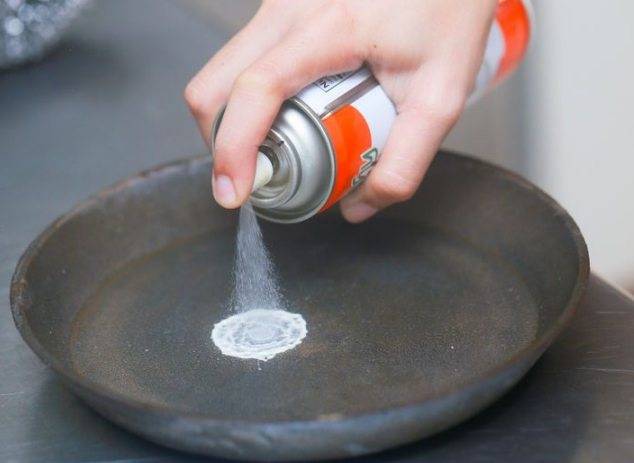 Apply the product
Apply the product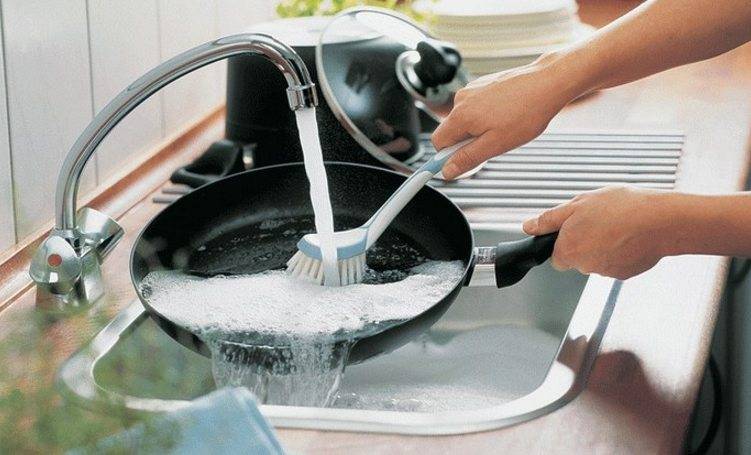 Rinse the dishes well
Rinse the dishes well
Remove rust quickly and safely
Rust on a cast-iron cauldron, frying pan, saucepan is removed in two steps. After the restoration measures, the food will not burn and the food will be tasty. So, I tell you what to do and how to clean the rust.
Stage 1. Neutralize damage
The first steps, how to remove rust from a cast iron pan, are the treatment of rusty places. Heavy deposits will have to be cleaned with an abrasive copper / steel scrubber. Weak stains are removed with abrasive powders. For example:
- Pemolux;
- Chistolin;
- Comets;
- Biolan;
- Chistin, etc.
There are other ways to wash off rust at home. Here are 4 available and effective methods.
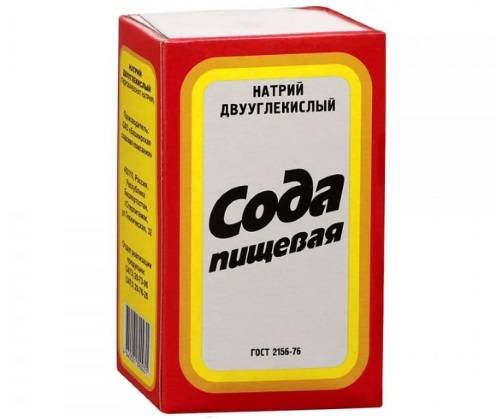 |
Method 1. Baking soda
Copes with light spots, shallow corrosion. Pour in baking soda, add a little water.Rub the resulting gruel into problem areas. Weak plaque is removed in 2 minutes. Old stain in 2 doses, with intermediate rinsing and applying a fresh batch of soda. It is recommended to use an abrasive sponge or brush |
 |
Method 2. Coca Cola or Pepsi
This product effectively replaces chemicals and helps to clean the cast iron pan from rust. Pour 1 glass of the drink into the dish so that the problem spots are covered. Heat over a fire until boiling. After cooling, rinse and dry the dishes |
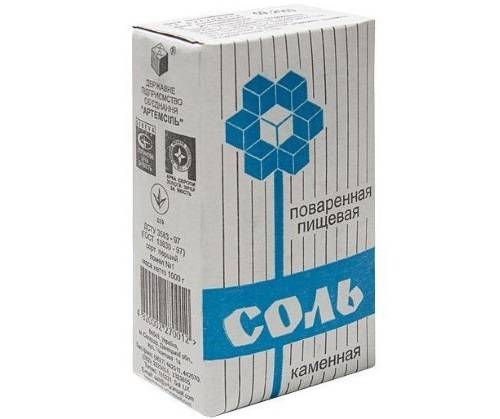 |
Method 3. Table salt
Salt moistened with water "works" as a soft abrasive. Salt gruel helps to clean a cauldron at home, a grill pan. It is more convenient to rub with a sponge or cellulose sponge cloth |
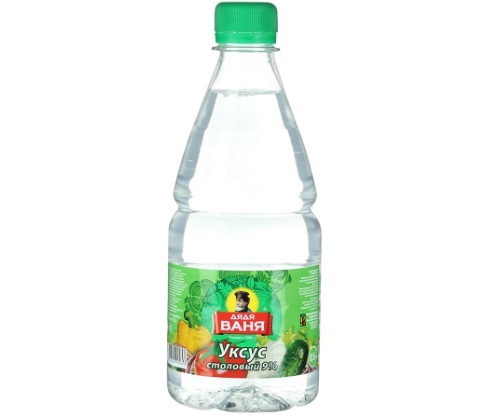 |
Method 4. Vinegar
It is used at the first sign of rust. A vinegar solution is made: 2 tbsp. l. + 1 glass of water. The dishes are poured for 2 hours, washed and dried |
If you do not know how to clean rust, use one of these methods. Fully cleaned cast iron cookware goes to the next stage of processing: to create protection.
Stage 2. Create a protective layer
Our task is to close microcracks, cast iron pores, block the formation of rust and eliminate the adhesion of food during cooking. The process is carried out in 3 steps:
| Photo | Step by step actions |
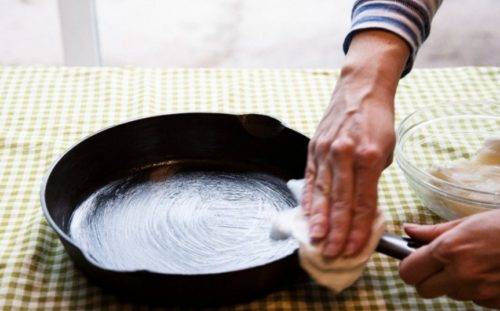 |
Step 1. Apply oil
Pour vegetable oil into the bottom of a clean frying pan, 1 tbsp is enough. l. Using a cotton pad, spread evenly over all surfaces (inside and outside). It is better not to use olive oil, it will smoke |
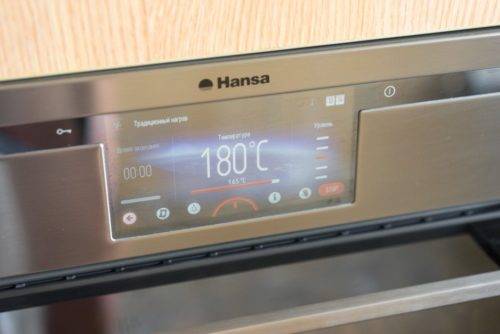 |
Step 2. We heat the oven
While the greased dishes are saturated with fat, heat the oven to 180 ° C |
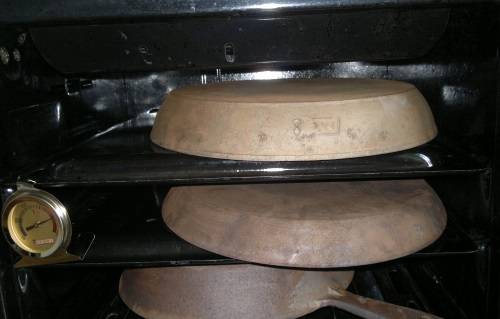 |
Step 3. Ignite the dishes
Firing allows oil to penetrate into all microcracks, seal them, improve non-stick properties and eliminate corrosion. Place the skillet upside down on a baking sheet and set aside to roast in the oven. After an hour, turn off the heat, the cooling should be gradual - do not immediately remove the dishes from the oven |
Firing is necessary when rust appears in a cast iron pan. The method is used for cauldrons, pans, pots, grill pans. After this procedure, the dishes become ideal for cooking.
How to remove rust from a cast iron pan
- Provided that the rust on the pan is weak, it is removed using any detergent with an abrasive component. Use a metal sponge as a cleaning tool.
- When rust takes up significant space on the surface of the pan, soak it in a suitable container. Pour hot water with vinegar into the container. As the vinegar boils, the rust will flake off both inside and out. Usually the whole vinegar bath procedure lasts from 30 minutes to an hour. Then the pan is washed with warm water and dried thoroughly.
- Prepare a solution of half a packet of baking soda and 6 liters of hot water. Place the container with the solution on the stove. Dip a frying pan into it and boil over low heat for several hours.
By applying all of these methods, you will bring your old cast iron pan back to life.
Creation of a reliable protective layer
We found out how to remove rust from a cast iron pan, now let's move on to creating a protective layer on the dishes. This process is possible both after cleaning corrosion from kitchen utensils, and as a prevention of the appearance of dark spots. If you follow the following list of actions, then the pan will always be clean and you will not need to clean it again from rusty spots:
- Grease the dishes with vegetable or linseed oil, but not olive oil, otherwise, when cooking at home, it will smell strongly of burning and the pan itself will begin to smoke. It is necessary to rub only one tablespoon of oil into the bottom of the utensil with a paper napkin.
- Heat in the oven at 180 degrees, this must be done before greasing the pan with oil.Heating up the cast iron or firing it takes 60 minutes. Remove the kitchen utensils from the cabinet after they have completely cooled down, so your hands will not get burned on the hot dishes.
- After firing and cleaning, the dishes can be washed with hot water and a soft sponge.
 Annealing of utensils should be done after the first cooking of food.
Annealing of utensils should be done after the first cooking of food.
Reasons for the appearance
Correct use can help reduce the incidence of rusty marks on your skillet. The most common cause of plaque is inattention and carelessness.
Improper washing
Abrasive substances must not be used to wash the cast-iron surface, since they lead to a violation of the protective layer. This cleaning method can only be used on an already damaged pan that has developed corrosion.
Poor preparation for operation
Before using the pan directly, grease it with vegetable oil and heat it with salt for 40-60 minutes. The procedure can be performed on the stove or in an oven at a temperature of about 180 degrees. Annealing will improve the protective properties of the enamel and create a layer that prevents the formation of rust.
Low-quality product
The use of low-quality materials for the production of kitchen utensils leads to rapid destruction of the protective layer and corrosion. To avoid such a situation, you must carefully select the product and purchase it in trusted stores.
Violation of storage rules
Long-term storage of a cast iron skillet without using it for cooking is a common reason why the coating will rust over time. If you do not need to constantly use the dishes, you should periodically oil them. In this case, you can only lubricate a clean and dry frying pan.
High air humidity
Exposure to high atmospheric humidity negatively affects the safety of the protective layer. If the frying pan is used frequently and correctly but is still rusty, more suitable storage conditions should be provided.
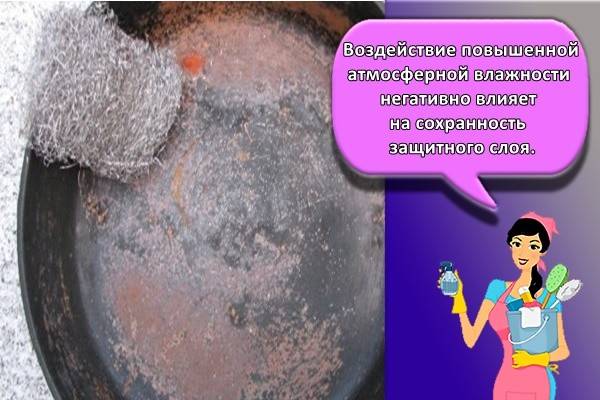
Improper care
Care must be taken when using a cast iron skillet. External mechanical stress can lead to cracks, chips and other damage. Destruction of the surface significantly increases the risk of material corrosion.
Causes of rust
There are several main reasons for the formation of corrosion in cast iron pans. This is inadequate care of dishes, rare use, poor-quality workmanship. Each case has its own advice for getting rid of rust.

Rice. 1 - Frying pan without proper care
Improper dish care
Corrosion is the result of iron oxidation. A chemical reaction occurs due to the constant exposure of the metal to water. If you use the pan, but do not dry it, rust stains will form faster. Also, among the reasons contributing to the appearance of corrosion, there are:
- Untimely removal of food debris - they must be removed immediately after cooking, otherwise sticking of the pieces cannot be avoided. Where food comes in contact with metal, corrosion can occur.
- The use of coarse abrasives - they destroy the top protective layer of the dishes.
At home, for cleaning, you need to use soft substances that will take good care of cast iron. It is recommended to clean cast iron cookware regularly.
Low quality metal
Kitchenware manufacturers do not always follow the manufacturing process, for example, they use low-quality materials to keep costs down. If in the production process a porous metal was used, calcination was not carried out, then problems cannot be avoided.
Nagar
The first and easiest way to get rid of carbon deposits in pans at home is to use household chemicals. It is just designed for these purposes, but its use is not always safe, especially if it is poorly rinsed off the substance after cleaning. When using household chemicals to clean the pans, you must use rubber gloves and a respirator. In addition, it is necessary to ventilate the area where the pans are being cleaned, as the fumes from these chemical cleaners can negatively affect the respiratory tract. If you don't want to risk your health, but you need to clean the pan of strong carbon deposits, then we advise you to use folk remedies that have repeatedly justified themselves, showing fairly good results. To clean the cast-iron pan from the outside of carbon deposits, you can use a blowtorch. Yes, you heard right. The method is slightly specific, but it will help to remove carbon deposits in a few steps, without putting much effort. All you need to do is direct the torch of the switched on blowtorch to the outside of the pan, and in this way clean it in 5-10 minutes. It is highly desirable to protect the apartment from fire. It is best to carry out this cleaning only outdoors, away from flammable objects. Another way to clean long-term carbon deposits from a cast iron pan is to use sand. The sand must be poured into a bowl, covered with a lid and sent to a very slow fire for several hours. This procedure is estimated to take about four hours. In this case, a very specific smell is possible, therefore it is better to open the windows and turn on the hood. After the sand is thoroughly warmed up in the pan, pour it out, and then gently tap the pan on a hard, unbreakable surface. The carbon deposits should spill out easily, after which the pan will need to be thoroughly rinsed with detergent. Another way to deal with carbon deposits in a cast iron pan is to use activated charcoal tablets. To do this, grind them to a powder state, then moisten the pan a little and sprinkle with the resulting powder. Leave on for a couple of hours and then rinse with a cleaning agent.

What do you need to do to remove rust from the pan?
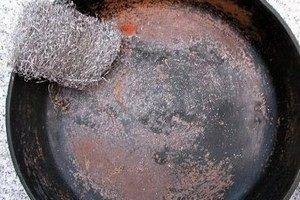 Scrub the rusty surface thoroughly with a hard washcloth. A copper or steel wire scouring pad is ideal for this purpose. Abrasive products that do not contain metal, such as :, Brillo, SOS and so on, are also very effective. If you can't remove rust with a washcloth alone, just add a little dishwashing gel.
Scrub the rusty surface thoroughly with a hard washcloth. A copper or steel wire scouring pad is ideal for this purpose. Abrasive products that do not contain metal, such as :, Brillo, SOS and so on, are also very effective. If you can't remove rust with a washcloth alone, just add a little dishwashing gel.
1. You will hardly be able to remove rust from a cast-iron pan in the same way as ordinary pans. Most often, this helps to remove the protective surface that has formed on the cast iron over time. If the dishes start to rust, then this protective layer has already been broken at some time. Therefore, you first need to get rid of such an annoying problem as rust, and then subject the pan to fire.
2. If rust is easy to remove from the surface, then it can be easily cleaned off with ordinary baking soda, which is found in almost every home. If the rust layer is very thin and barely noticeable, then you can also sprinkle the bottom of the pan with soda, add water until a mushy mass is obtained, and then moisten a piece of cloth in the resulting composition and wipe the stains. After rubbing the paste into the rust, leave it to enhance the effect for a few minutes, then rinse under running water.
3. Ordinary table salt can also help you to remove rust from the frying pan. Similar to the previous method, prepare a gruel from salt and water and rub the rust stains with a rag soaked in this composition.Since the salt granules are larger and much harder than the baking soda granules, this paste is suitable for more severe stains. But still, in comparison with household chemicals, this is a more gentle and harmless remedy.
4. If the traces are already old, then the dishes can be cleaned of rust only with the help of aggressive, chemical cleaning agents. For this purpose, absolutely any economy-class toilet bowl cleaner is suitable, since they consist of more than 20% hydrochloric acid. Hydrochloric acid can turn old rust into a damp powder, which you can easily wipe off with a kitchen sponge.
Most importantly, do not forget to read the instructions for use on the package, since hydrochloric acid is a very strong acid and its use requires great care. It can harm human health.
It should also be borne in mind that parts with a shiny coating, such as handles and bolts, will become dull and nondescript and lose their shine when exposed to acid. Wash the dishes thoroughly and pat dry with a paper towel and then a kitchen towel. Moisture on the surface can cause rust to form again. 5. Place the dry skillet on the stove and pierce over medium heat for about five minutes. This is necessary in order to remove moisture from the pan.
This should be done very carefully, as the pan will be very hot and can cause burns.
As mentioned earlier, after completely getting rid of all traces of rust, the cast iron pan should be baked. This forms a very useful protective layer on it, preventing rust and further burning. In the next part of the article, we will discuss the firing process in more detail.
Methods for cleaning rust from a frying pan
If we talk about how to remove rust from a cast iron pan, it should be noted that it is recommended to clean the dishes in 2 stages. First, the rust is removed, and then the protective coating is re-created.
To begin with, the pan is treated with an abrasive washcloth - it must be made of copper or steel wire. You can also use non-metallic abrasives.
If you cannot cope with the problem, you can use other means. To wash cast iron dishes at home, a variety of substances are used. If rust appears in a cast iron pan, what should be done in such a situation?
Rusty stains on the pan can be removed with a grinder and a metal brush
Baking soda
If the damage did not have time to penetrate the structure of the product, and it has a light shade, ordinary soda will help to eliminate the problem. Pour it on the bottom of the pan and add a small amount of water to get a thick gruel.
Take a clean sponge and rub the product into the stains. If it was not possible to clean the rust and other stains from the cast-iron frying pan the first time, the procedure should be repeated or use another remedy.
Salt
Cleaning with salt is much the same as cleaning with baking soda. For this, the substance is poured into a pan, mixed with water and the contaminated areas are rubbed with a sponge.
Salt is a great cleaner for cast iron skillets
Strong cleaning agents
If simple abrasives do not work, it is recommended to use stronger ones. A great option would be a toilet bowl cleaner. It contains hydrochloric acid, which converts rust into a wet powder. Removing it is not difficult.
It is very careful to use formulations based on hydrochloric acid. Protective gloves should be worn during work. Work must be done in a well-ventilated area. After completing the procedure, it is recommended to thoroughly wash the dishes and wipe them dry.
Metal brush
To clean the surface of the product in difficult cases, you can use a metal abrasive brush.To do this, cover a damp pan with powder and wipe off all stains.
Then it is washed in running water and proceeded to calcining. The dishes should be placed in a preheated oven for 40 minutes, greased with oil and heated for another 1 hour. Then the oil is reused.
It is best to ignite the dishes in the oven - this way the pan heats up evenly
Vinegar solution
Table vinegar helps to clean the cast iron pan. To do this, you need to mix the product with water. For 1 tablespoon of vinegar, take 1 liter of water. Pour the solution over the dishes and leave for 2 hours. Then wash and dry thoroughly.
Digestion
This is a fairly old folk method that has high efficiency. To cope with the problem, pour 6 liters of water into an enamel bucket and dissolve half a packet of soda.
A frying pan is lowered into the resulting mixture, and the bucket is put on low heat. It is recommended to digest the composition for 1-2 hours.
Coca Cola
What to do if the cast iron frying pan begins to rust on the inside and is covered with nasty stains? In this case, it is worth using the effective method. To do this, pour cola into a deep bowl, put a frying pan there and bring to a boil. Then the stove is turned off.
It is recommended to cool the dishes directly in the solution. Then the pan should be rinsed, wiped dry and heated in the oven. This method is suitable for regular items and for a grill pan.
Coca-Cola is great for getting rid of rust stains and deposits in the pan.
Fish fat
When using this method, it is sufficient to grease the surface of the pan with fish oil. Moreover, this must be done both outside and inside. After which the composition is left for 3-4 hours. The pan is then washed in warm water with a mild detergent, gently scraping off the rust. To do this, use a stiff brush.
At the next stage, it is recommended to create a protective layer on the surface of the product. For this, it is permissible to use any oil - sunflower, peanut, rapeseed. Do not use olive oil. It quickly begins to smoke, which leads to an unpleasant odor.
To perform the procedure, 1 tablespoon of oil is poured into the bottom of the pan and spread over its surface with a paper towel. It is recommended to preheat the oven to 180 degrees and place the dishes in it upside down.
Wait 1 hour, then turn off the oven. However, you should not open it right away. The oven must cool completely. Only after this is the pan removed.

